Fear and loathing at a South Shore co-op

 By MAYA DUKMASOVA 10
By MAYA DUKMASOVA 10



 By MAYA DUKMASOVA 10
By MAYA DUKMASOVA 10


04 Sightseeing Field notes from the 1919 Committee of Fi een’s hunt for sex workers.
that shaped Chicago’s lesbian culture.
22 Performing Arts Super Tasty brings sex education to Constellation.
27 Plays of note BoHo’s Big Fish breathes life into tall tales; Hell in a Handbag’s Halloween show spoofs The Facts of Life; and Cowardly Scarecrow’s barroom production of Cabaret is haunting and timely.

31 Movies of note Bong Joon-ho’s camerawork and mise en scene are impressively subtle in Parasite; Fritz Lang’s adventure saga The Tiger of Eschnapur and The Indian Tomb shouldn’t be missed; and Joaquin Phoenix is outstanding in the gritty, downbeat comic book movie Joker
CHICAGO READER | OCTOBER 10, 2019 | VOLUME 49, NUMBER 2
TO CONTACT ANY READER EMPLOYEE, E-MAIL: (FIRST INITIAL)(LAST NAME) @CHICAGOREADER.COM
EDITORS IN CHIEF SUJAY KUMAR, KAREN HAWKINS DEPUTY EDITOR KATE SCHMIDT
CREATIVE LEAD SUE KWONG
43 The Secret History of Chicago Music Countrified rockers Possum River emerged from the breakup of the Cryan’ Shames
46 Early Warnings Dead Can Dance, Fabio Frizzi, Sinead O’Connor, and more justannounced concerts
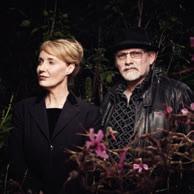
06 Feature Marz Community Brewing’s nonalcoholic drinks are just as wild as its beers.

08 Joravsky | Politics Chicago teachers have almost no relief for overcrowded classrooms.
10 Dukmasova | Housing Oglesby Manor survived the Great Depression and the Great Recession. Will gentrification and neighborly discord spell the death of this South Shore co-op?

20 Visual Art “Lavender Women & Killer Dykes” shines a light on the people, places, and publications
23 Sports How I ran away from my failing body and straight into the Chicago Marathon

46 Gossip Wolf Filmmaker Jim Sikora screens a rarely seen love letter to Saccharine Trust, Sacha Mullin celebrates a silly new video for an old song, and more.
47 National Politics Why I can’t get excited about impeaching Trump
48 Savage Love Dan Savage offers advice about using lasagna in the bedroom, hating your partner’s mother, and more.
TYPICALLY WHEN I story, I find that someone with more power is exercising it in a way that hurts someone with less power. In situations where low-income tenants are grappling with exploitative landlords, or public housing residents are battling recalcitrant city o cials, or homeowners face o against predatory lenders, narratives are relatively simple to construct. In this story about a struggling South Shore co-op it was clear that the problems residents have experienced are real, and the stakes for resolving
the paper in the first place while honoring the experiences and perspectives of those who welcomed the intervention of a reporter.
DIRECTOR OF PHOTOGRAPHY JAMIE RAMSAY MUSIC EDITOR PHILIP MONTORO
THEATER AND DANCE EDITOR KERRY REID ASSOCIATE EDITOR JAMIE LUDWIG
SOCIAL MEDIA EDITOR BRIANNA WELLEN SENIOR WRITERS DEANNA ISAACS, BEN JORAVSKY, MIKE SULA
STAFF WRITERS MAYA DUKMASOVA, LEOR GALIL EDITORIAL ASSOCIATE S. NICOLE LANE
LISTINGS COORDINATOR SALEM COLLO-JULIN FILM LISTINGS COORDINATOR PATRICK FRIEL DIGITAL REPORTING INTERN AARON ALLEN CONTRIBUTORS NOAH BERLATSKY, LUCA CIMARUSTI, ISA GIALLORENZO, JACK HELBIG, IRENE HSIAO, DAN JAKES, CATALINA MARIA JOHNSON, MONICA KENDRICK, MEGAN KIRBY, STEVE KRAKOW, JAMIE LUDWIG, MAX MALLER, BILL MEYER, J.R. NELSON, LEAH PICKETT, JAMES PORTER, BEN SACHS, DMITRY SAMAROV, CATEY SULLIVAN
DIRECTOR OF DIGITAL JOHN DUNLEVY DIRECTOR OF PUBLIC ENGAGEMENT & PROGRAMS KRISTEN KAZA
OFFICE MANAGER SORAYA ALEM ADMINISTRATIVE ASSISTANTS
JANAYA GREENE, YAZMIN DOMINGUEZ
312-392-2970, DISPLAY-ADS@CHICAGOREADER.COM CLASSIFIEDS: SALEM@CHICAGOREADERCORP.COM
SALES DIRECTOR PATTI FLYNN
VICE PRESIDENT OF SALES AMY MATHENY CLIENT RELATIONSHIP MANAGER TED PIEKARZ SENIOR ACCOUNT REPRESENTATIVES
BOB GRIFFITH, JORI LIEFSCHULTZ, LENI MANAAHOPPENWORTH, LISA SOLOMON CLASSIFIED SALES MANAGER WILL ROGERS
NATIONAL ADVERTISING VOICE MEDIA GROUP 1-888-278-9866
VMGADVERTISING.COM
JOE LARKIN AND SUE BELAIR
DISTRIBUTION CONCERNS distributionissues@chicagoreader.com 312-392-2970
BOARD PRESIDENT DOROTHY R. LEAVELL TREASURER EILEEN RHODES SECRETARY JESSICA STITES AT-LARGE SLADJANA VUCKOVIC
CONSULTANT CAROL E. BELL
READER (ISSN 1096-6919) IS PUBLISHED WEEKLY BY STM READER, LLC 2930 S. MICHIGAN, SUITE 102 CHICAGO, IL 60616 312-392-2934, CHICAGOREADER.COM
COPYRIGHT © 2019 CHICAGO READER PERIODICAL POSTAGE PAID AT CHICAGO, IL
ALL RIGHTS RESERVED. CHICAGO READER, READER, AND REVERSED R: REGISTERED TRADEMARKS ®
In last week’s review of Sideshow Theatre Company’s production of “stroboscopic.” The company has alerted us to the fact that there are no strobe e ects used in the show. We regret the error.



 By JEFF NICHOLS
By JEFF NICHOLS



didn’t concentrate its e orts on instituting a state minimum wage as a means of discouraging women from sex work, as other anti-prostitution activists had advocated. Rather, the committee “directed its e orts chiefly to the work of destroying marketplaces for tra c in women,” forwarding evidence to prosecutors and publicizing the worst o enders to pressure politicians.

The committee didn’t partner with the police. Instead, Thrasher sent investigators to hunt for “houses of ill-fame” throughout the city. These were not churchy sleuths writing down the addresses of houses that looked dodgy. “She wore a pink silk kimono, exposing her entire body to us,” an investigator wrote of a resident at 4021 S. Calumet.

In the late evening of July 10, 1919, two men walked into a saloon at 3156 W. Lake, asking the bartender if there were “any ‘skirts’ around.” The bartender replied that they should come back in 30 minutes. Upon their return, two women at a table in a rear room beckoned them with the greeting, “Hello, kids.” After a round of drinks, the women introduced themselves as Loraine and Marge, who “solicited both of us to prostitution for the sum of $5”—an amount that, when adjusted to inflation, comes to about $127 today. “They said that they had to be careful where they ‘jazzed,’ and for that reason they would jazz us in Garfield Park or a taxicab.”
As it happens, the two men weren’t looking for a good time in Garfield Park. They were undercover investigators reporting to the Committee of Fifteen, a private anti-prostitution organization. Founded in 1908, the group came into prominence during the debate whether to close the Levee, Chicago’s notorious redlight district north of Cermak, between Clark and Wabash. Surrendering to public opinion, Mayor Carter Harrison ordered in November 1912 that the Levee, with its wide-open houses of prostitution, be shut down. The Committee of Fifteen was determined to make sure that commercialized vice did not return to the Levee or spread to other neighborhoods.
On the board of the Committee of Fifteen were the heads of Chicago companies such as Sears, First Bank of Chicago, and Quaker Oats. Samuel P. Thrasher, a publicity-savvy New Englander with a background in combating vice, was hired as superintendent. The committee
Their field notes record the asking price for sex acts (often using slang terms such as “jazz” or “French”), the names and descriptions of “inmates” (sex workers) and “keepers” (madams or pimps), and other details that might aid in future prosecutions, such as the sale of alcohol or the presence of children. They also kept notes on cops. “A policeman stepped in this place for a minute and then the woman in charge told us not to fear him because she pays him and he would protect us,” one investigator wrote about a house in South Chicago.
Though mostly straightforward and repetitive, their field notes on occasion allow glimpses into the backgrounds of sex workers in Chicago. An investigator reporting at 644 N. LaSalle on September 7, 1918, wrote that the keeper “tells me that her home is in Saint Louis; that her dead sister was a nun.” An inmate named Dolly “works in the basement of Marshall Field & Co . . . Dolly’s husband has gone o to war.”
At the Empress Hotel in Englewood, investigators checked in and told the proprietor they wanted to bring up two women who weren’t their wives, asking “how to work it so we would not get in bad if the police came in.” She replied that she would put them in two rooms connected by a door.
In addition to visiting “disorderly” saloons like the one at 3156 W. Lake, Thrasher’s men ran up tabs at cafes, cabarets, and dance halls. Investigators wrote up night spots visited by unaccompanied women drinking, smoking, dancing suggestively, or using vulgar language.
Freiberg’s—a dance hall owned by Ike Bloom, a vice lord during the Levee’s heyday— set patrons up with dancers, who would order
A century ago, the Committee of Fi een hunted for “houses of ill-fame.”
drinks. “Between each dance girls would walk around [the] dance floor singing, the people sitting around at tables would toss coins to them,” one investigator wrote in August 1917.

The shoulder strap of one dancer “slipped down exposing her right breast, the man she was dancing with held her tightly against himself.” An entertainer at Freiberg’s o ered to have sex with another investigator for $5.











She explained she wasn’t allowed to solicit at work, but she could do as she pleased away from her job, which paid $15 a week.
















Though typically working in the safety of pairs, investigators sometimes felt threatened. One enforcer told investigators, “[I] know who you—are, you are Thrasher’s men, and I am going to kill you both.” They escaped with a warning not to be caught investigating the south side.


The buddy system also a orded some protection against temptation. The field notes on occasion show that working in pairs helped investigators find excuses for leaving when they were pressured to sleep with sex workers. One investigator resigned after catching his superior making out with a woman who was not his wife during work hours. Of the five men who can be identified as investigators between 1915 to 1920, all were married.
The First World War was a boon to the Committee of Fifteen. The federal concern of keeping soldiers and sailors sober and free of venereal disease resulted in a five-mile vice-free zone radiating from the Federal







Building at Dearborn and Adams. Within this zone, brothel keepers faced harsh penalties. Throughout the city, the sorts of hotels and clubs that antivice advocates despised came under significant pressure.
But by 1923, the committee had suffered a number of humiliating setbacks, undone by the sort of corruption it felt it was above. Thrasher’s extravagant praise of chief of police Charles Fitzmorris alienated antivice critics of police inaction. The discovery that Thrasher had concealed large donations from Fitzmorris triggered a run of resignations from his board. The operator of one south-side brothel testified that Thrasher’s chief investigator had tried to shake her down for protection. Another investigator on his rounds in the Black Belt intruded in a domestic dispute involving a woman he erroneously presumed to be white. He shot a Black man who asked to see his badge. Although the killer had been a recent hire, investigators had, in their secret notes, long expressed contempt for racial mixing on the south side.
By the time of Thrasher’s death in 1925, the committee had lost much of its power. It finally closed shop in 1951, claiming vice was at an all-time low. v
The records of the Committee of Fifteen can be found at the Special Collections Research Center, University of Chicago Library.








 @backwards_river
@backwards_river


Last week a latch popped on the main mash tun at Marz Community Brewing, sending water, wheat, and oats cascading all over the floor. What was intended to become an IPA overwhelmed the drainage system and “it just halted the day,” says Joe Guzzo. “Anyone who says that brewing is not a glorified janitorial occupation doesn’t know what they’re talking about.”
Guzzo doesn’t make beer at Marz, and he’s not a janitor either, but his job as the Bridgeport brewery’s nonalcoholic brewmaster does involve the occasional mishap. The cleanup interrupted his plan for the day, which involved, in part, some R&D on a small batch of sparkling water that incorporates, among other things, a dose of Japanese oyster powder he picked up on a recent visit to Rare Tea Cellar.
“What’s that taste like?” I wondered well after the spill was contained.
“Huge upfront brine with an incredibly pure oyster flavor,” he texted back. “Funky without being overbearing. Surprisingly approachable.”
In addition to its prodigious malted output, Marz has plunged into the nonalcoholic beverage arena over the last year, canning and bottling shrubs, kombuchas, waters, co ees, and other intoxicating—but alcohol free—beverages, such as a sparkling yerba mate and a

delicately floral CBD-spiked seltzer with seven di erent botanicals that makes your favorite La Croix flavor taste like fizzy hand lotion.
Guzzo, a former EPA geologist, has been behind every one of them. “It was just a fun thing that was happening on the side,” he says.
“We enjoy beer, but we also all drink seltzer, and that was just something that was pretty easy to do.” But eventually talk of a bubble in the brewing industry led to a more concerted e ort to diversify and make drinks that appeal to the health conscious while being every bit as complex, nuanced, and, often, experimental as the beer.
Guzzo’s mother ran a catering operation in Colorado, where he grew up, and a love for cooking stayed with him long after he graduated from NIU and began conducting air and water tests for the feds on remote field trips across the rust belt.

“I would get kind of homesick just from being on the road,” he says. “It was a huge thing just going into the local specialty food store and perusing for no reason. I didn’t even have a kitchen in my hotel room. Just putting my headphones on and strolling through grocery stores is one of my favorite pastimes.”
He was laid o in 2015, a trickle-down e ect of federal budget sequestration, and like most suddenly liberated cooks who want to steer clear of professional kitchens, he started J
Marz Community Brewing’s nonalcoholic drinks are just as wild as its beers.Joseph Guzzo, pictured at le bottling kombucha and above in Marz’s tasting room, is the brewing company’s nonalcoholic brewmaster. KATHLEEN HINKEL FOR CHICAGO READER Marz Community Brewing’s LIQUID DREAMS FESTIVAL is Saturday, October 12 , from noon to 6 PM at 3630 S. Iron. It’s free, but 21+, with food and drink tokens for sale. A $ 40 festival package available in advance includes a T-shirt, a commemorative tasting glass, a four-pack of Liquid Dreams Hazy IPA, and three food or drink tokens.
an Instagram account, @not.junk.food, documenting his passion. “It started turning into an educational thing. I have all these friends who love food who didn’t know how to cook for themselves. I was just, ‘Here are all these little tips and tricks that I can share.’”
This led to pop-ups at the quarterly parties he and his roommates threw at the 5,000-square-foot art space where they live, and where he cooked hundreds of servings of lumpia, Chengdu-style dumplings, fried rice, and five-spice tofu larb. Private dinners and remote pop-ups followed and continue.


About two and a half years ago he started bartending at Marz, but also gradually spending more time in the basement working on small-batch, booze-free experiments, applying the scientific method he’d trained for on cold-brew co ees, mango-hibiscus-cardamom shrubs, and raspberry-rhubarb CBD elixirs.
This period also covered his early introductions to the janitorial aspect of zymurgy. “I’ve gotten covered from head to toe in guava,” he says. But “most of the time when I thought something was gonna be absolutely terrible, those are the best things I’ve made.”
Eventually six draft lines in the tap room were dedicated to Guzzo’s most successful concoctions, and they formed the foundation of the cans and bottle they’re releasing today. Marz Mate is a lightly lemony, sparkling expression of the supercaffeinated South American herbal tea yerba mate. Flower Power is a seltzer flavored with chamomile, heather tips, grapefruit, hibiscus, bergamot, gentian, and lemon, charged with 20 milligrams of hemp-derived CBD. Outre Kombucha is a single-origin jade oolong tea fermented for 20 days in 59-gallon new oak barrels. The 12-ounce can of Marz Co ee is a fruit-forward
medium-roast bourbon bean sourced from a single El Salvadoran farmer, roasted at Bridgeport Coffee, and impregnated with a five-milliliter shot of nitrogen that expels the oxygen but when shaken produces the kind of smooth body and creamy head you’d enjoy in a good stout. Another coffee, Tokyo Drift, is on deck, dosed with 30 milligrams of CBD and brewed from a bean fermented in its own fruit, yielding funk and bright acidity.
For all of this variety, there’s a common denominator to Guzzo’s palate. He creates everything with an instinctive restraint on sweetness that highlights the interesting flavors he’s working with.
“I think there’s a lot of beverages in the general market that use sweetness as a crutch,” he says. “You can really cover up a lot of things and also just imbalance entire beverages. Not everything you eat and drink should give you instant gratification. I don’t want to sacrifice complexity and depth by overpowering it with something like sugar.”
Sweetness won’t get in the way of the oyster powder either, which he’s infused in a sparkling yuzu-flavored heirloom tomato water that he’s planning to pour along with the rest of Marz’s nonalcoholic offerings and some surprises at this Saturday’s Liquid Dreams Festival, celebrating the brewery’s fifth anniversary.
“I really try to take cooking and the culinary world into the beverage world,” he says. “Anybody can take fruit juice and carbonate it, but not everybody can reimagine what it means to have a tasty nonalcoholic beverage that can be challenging in the way food can be challenging.”
@MikeSula
Chicago teachers have almost no relief for overcrowded classrooms.
By BEN JORAVSKYAfter last week’s column about the looming Chicago teachers’ strike, I heard from teachers with horror stories to tell about overcrowded classrooms—among other things.
Nothing new about that. I’ve been hearing horror stories about overcrowded Chicago classrooms since I moved to town in the early 80s.
But this year the teachers may strike over it—anything to force Mayor Lori Lightfoot to agree to a contractually enforced cap on the number of students in a classroom.
One horror story came from a sixth-grade teacher on the southwest side who didn’t want her name or school mentioned. She had 43 kids in a classroom for most of last year.
I’m sure you can imagine what that’s like. Not enough desks for the students. Barely enough space in the room. Not enough books. More papers to grade. Harder to keep everyone’s attention. More challenging to meet the needs of the slower-learning kids without los-
ing the attention of the faster-learning kids. And so forth.
She appealed for help. But there was not much the principal could do since there was no money to hire another teacher. CPS finally brought in a teaching assistant to help, but she was as green as the apples in the O.C. Smith song. The teacher ended up teaching the assistant almost as much as the kids.
When you hear stories like that, it’s no wonder that more than 90 percent of teachers voted to strike.
As things now stand, there’s almost nothing teachers can do when their classes are overcrowded. There’s no language in the union contract that forces CPS to move students out of overcrowded classrooms. Teachers can’t grieve the matter—that is, appeal it to an arbitrator.
CTU is prohibited by state law from even negotiating over the issue—the only union in the state with such a prohibition. If they strike over it, well, it’s technically an illegal strike.
NICOLE HONEYWILLAnd Mayor Lightfoot could go to court to ask a judge to slap a fine on the union or have its leaders tossed in jail.
Not saying the mayor would do that. But it’s an option.
The CPS attitude toward overcrowded classrooms is much like its attitude toward schools without nurses, social workers, and librarians. Tough luck. Now shut up and go back to work.
Curious to see if other school districts have a similar indifference to jamming students into classrooms, I spent the better part of Sunday reading through various suburban union contracts. Don’t feel too sorry for me—it was a welcome distraction from the wretched play of the Chicago Bears.
In short, Chicago is by far the worst when it comes to overcrowded schools. According to the CPS contract with the Chicago Teachers Union, board policy on class size is set “by section 301.2 of the Chicago public schools policy manual.”
To avoid the Bears, I meandered over to good old section 301.2 in the CPS policy manual, where I found the following sentence:
“The total number of intermediate and upper grade students will be divided by 31 on a whole number basis, i.e., the division will not be extended to a decimal place. If the division is uneven, then the remaining students will be included in the primary membership.”
Got that? Wait, there’s more . . .
“The total number of kindergarten students will be divided by two, extended to one decimal place, and rounded up to the nearest whole number; this number will then be divided by 28, extended to one decimal place, and rounded up to the nearest half number.”
Glad that’s clear. Bottom line, CPS has class size goals of 28 kids in kindergarten and primary school and 31 in high school.
But these are just goals. If class size goes above 28, there’s not much teachers can do about it, except wait till next year and hope things get better. Sort of like me and the Bears.
And you wonder why so many teachers in Chicago think CPS just doesn’t give a shit about what goes on in classrooms—especially those in low-income neighborhoods.
In the suburbs? Well, it’s a mixed bag. Some union contracts are more forceful than others.
District 97 in Oak Park automatically sends a teaching assistant to a kindergarten class that exceeds 21 students or an upper-grade class that goes above 24.
Some districts pay teachers extra money for overcrowded classrooms. District 99 in Cicero “agrees to pay a teacher, whose class exceeds thirty students, fifty cents per student per period per day.”

You know, I think I may have found a district as cheap as Chicago’s.
It’s a little better in Lake Forest. If teachers think they have too many kids in a class, they can request a meeting with the principal. If that doesn’t alleviate the problem, they can request a meeting with the superintendent. If that doesn’t work, they can file a grievance. However, “only violation of the process can be grieved. The substance of the final report is not grievable.”
It’s similar policy in School District 39 in Wilmette. “The intent of this provision is to provide a process for teachers to raise concerns about class size and have the concern heard and addressed by the administration. The provision is not subject to the grievance process.”
Of course, I have a hard time imagining parents in Wilmette or Lake Forest—two wealthy suburbs—putting up with more than 25 kids in a grammar school classroom, much less 43. They’d be on the phone raising holy hell and would probably run a slate in the next school board elections.
Which reminds me—Chicago still has an appointed school board.
Some of the strongest language comes from the union contract in District 64 in Park Ridge. If the union feels “the board has acted arbitrarily or capriciously with respect” to overcrowding, “it may file a grievance.”
Now that’s how you write a contract! My recommendation to students or teachers in an overcrowded Chicago classroom? Move to Park Ridge.
Consider it the Marie Antoinette approach to overcrowding in Chicago. v
@joravbenThe Chicago Reader is community-centered and community-supported.





You are at the heart of this newspaper. Founded in 1971, we have always been free, and have always centered Chicago. Help us to continue to curate coverage of the diverse and creative communities of this fabulous city.




Your donation keeps the presses rolling. CHIP IN HERE: www.chicagoreader.com/members

Oglesby Manor survived the Great Depression and the Great Recession. Will gentrification and neighborly discord spell the death of this housing co-operative?
By MAYA DUKMASOVAAs temperatures dipped to 20 below zero on the night of January 29, Martha Hardy and Nakia Young were horrified that the radiators in their South Shore apartments stood cold. The neighbors live in a 21-unit brick building on the southwest corner of 70th Street and Oglesby Avenue. To their surprise, when they contacted other residents, some said they had heat. It didn’t make sense. The whole building only had one source for heat, an enormous Kewanee boiler in the basement. Young, 39, was particularly worried as she bundled her two small children and plugged in space heaters; she, the kids, and her mom all slept in the same bed that night.
Hardy, 65, fired up a portable heater and the stove with the door open to warm up, though that heat didn’t make it far through the length of the shotgun-style apartment.
Hardy tried reaching the building’s management company the next day, but when she didn’t hear back she decided to report the outage to the city. When a Department of Buildings inspector arrived at five that afternoon, he measured a temperature of 55 degrees in Young’s first-floor apartment, 60 degrees in Hardy’s second-floor apartment, and 54 degrees in another neighbor’s apartment. “All radiators cold to the touch, no heat provided,” the inspector noted in all caps in his report.
“Entire building . . . without heat—Boiler system out of service at time of inspection.”

McKey & Poague, the management company, did begin repairs, but not in time to prevent the pipes from freezing on the second night
of the city’s historic polar vortex. When the boiler was finally back in order the radiators and plumbing began to leak.
“Water is coming from my radiators on my hardwood floors,” Hardy wrote in a text message on the morning of January 31 to one of the neighbors who had claimed she had heat. “There’s water in my living room ceiling from the up stairs radiators.” She said she’d be calling the city about it again. The neighbor responded three hours later: “FYI the city does not fix the problem they just come out and write tickets in which we all have to pay for including you!”
The heating outage and burst pipes were just the latest in a litany of problems plaguing the building, from a leaky roof to pest infestations to plumbing cloggages to hazardous porches. In the months that followed, Hardy, Young, and others in the building would continue to see water seep through ceilings and damage floors; sometimes they’d arrive home to bright orange utility shut-o notices taped to entrances. Then, men began showing up at their homes with ominous legal papers alleging debts owed to the building. But the magnitude of these problems paled in comparison to the rancor festering between neighbors. Meanwhile, the neighborhood outside has been grappling with the looming threat of gentrification. This building isn’t an income property run by an absentee landlord, or a stu y condominium where all the owners go it alone. It’s a co-operative—one of only about 100 of its size left in Chicago—where deferred maintenance of relationships is proving far
Oglesby Manor, a 21-unit co-operative apartment building in South Shore, is one of about 100 co-ops of its size le in Chicago.
 KRISTEN NORMAN FOR CHICAGO READER
KRISTEN NORMAN FOR CHICAGO READER
Ads for the newly constructed co-op ran in the Tribune in the summer and fall of 1925.
Reproduced with permission of the copyright owner. Further reproduction prohibited without permission.
more pernicious than the property’s physical and financial troubles. And what happens there in the next few years will either bolster or chip away at South Shore’s legacy as the last lakefront neighborhood where middle class African Americans can afford to own their own home.
In his 2004 book Chicago Apartments historian Neil Harris writes that South Shore “fully blossomed in the 1920s, when real estate companies undertook the massive development of newly purchased land tracts.” Oglesby Manor, the four-story building where Young and Hardy reside, was erected in 1925. It
was part of the tony South Shore Country Club district, north of the commercial thoroughfare on 71st Street. Ads for the building, which ran in the Tribune, included an image of the structure over the words “our sixth successful 100% co-operative apartment building.” The developers, brothers John and Richard Johnston, were among a wave of real estate men promoting co-operative apartments as the hot new form of property ownership.
Co-operatives (or co-ops) are apartment buildings or complexes that are owned by a corporation created for the sole purpose of maintaining the property. When people buy units, rather than buying a piece of the
building, they buy shares in the corporation that owns the building. Owning shares in the corporation entitles them to a perpetual lease on a unit. Each co-op has governing documents called bylaws and a board of directors—who are usually unpaid—elected by its resident shareholders. The board manages the building’s finances and facilitates collective decision-making. Shareholders pay monthly assessments that are used for property taxes and utilities and to maintain common areas and building systems. When big, unusual work is required, the board calls meetings about these matters and conducts votes on “special assessments” to be collected from shareholders to pay for the project.
Oglesby Manor wasn’t at the highest end of co-ops in 1920s South Shore. It wasn’t designed by a famous architect like some of the nearby apartment palaces featuring
underground garages, private gardens, Italianate loggia entrances, and rooftop recreation rooms. Whereas its largest apartments were priced at about $6,100 ($89,300 in today’s money), high-rise buildings a couple of blocks closer to the lake, for example at 6700 S. Crandon, offered similar size five- and six-room apartments that started at $6,000. Larger units went for $17,800. For context, the average home in America in 1925 cost $4,800.
Its modesty notwithstanding, Oglesby Manor was built with care: a state-of-the-art fire-tube boiler, generous bay windows, fireplaces, built-in shelving, door handles made of porcelain and glass. Though there were only eight garages, they were heated. The tiny black-and-white tile in the lobbies was arranged in attractive geometric patterns. There were no maids’ quarters or penthouses, but there was light and air in the spacious
two- and three-bedroom apartments with sunrooms, multiple closets, and private back porches.
Developers strived to convince would-be buyers that co-ops offered the sweet spot between costly, hassle-riddled single-family homes and the drudgery of rental apartments. When co-ops were first developed in the late 19th century, apartment ownership, like most homeownership in America, was reserved mostly for people who had the means to buy property in cash or were seen as trustworthy borrowers by banks—in other words, wealthy white people. A booklet on co-operative apartments printed by the Chicago developer Albert W. Swayne around 1924 noted that at the beginning of that decade “as many as 73 percent of the families in congested cities like Chicago are living in rented homes.” The pamphlet argued that “tenant ownership and

control” of apartment buildings would eliminate waste and bring down the cost of living. Oglesby Manor’s ads echoed this logic: “The expense of maintaining an apartment (taxes, janitor service, insurance, coal, repairs, etc.) is much less than its rental value or the expense of maintaining even the smallest individual home.”
By spring 1929, according to a survey conducted by the Chicago Real Estate Board, more than 20,000 Chicagoans lived in co-ops. The board even published the names of some of the most prominent co-op dwellers, ranging from noted capitalists to vaunted medical professionals to journalists, adding that it had “never heard” of a co-op defaulting on a loan. Later that year, however, after the stock market crash, many co-ops found themselves overleveraged and were converted to rental apartments. This was especially true of the more extravagant buildings. But the Oglesby Manor co-op was able to survive the Great Depression. In 1935 its articles of incorporation were amended to lower the price of stock in the building from $100 to $25 per share, presumably to adjust to the economic realities of the neighborhood. After WWII, as the federal government increasingly subsidized ownership of single-family homes, co-ops remained the province of the wealthy. Getting a mortgage for a co-op has always been tricky, as many banks are uncomfortable making loans secured by corporate shares rather than an actual piece of property. And so in most places outside New York City, which has long had robust financing options for co-ops, they persisted as a rather insular world, dependent on the ebb and flow of well-to-do residents. Rich people liked things that way, anyway. Because co-ops didn’t depend on federally insured mortgages, they were exempt from even the most basic fair housing regulations, allowing co-op boards to be as biased in their criteria for admitting new residents as they wanted.
The people who lived at Oglesby Manor after the war were mostly upper-middle-class white professionals. Not so wealthy as to be able to avoid work but prosperous enough to be featured in the Tribune’s society pages. They went from Protestant to Irish Catholic to Jewish, reflecting the demographic shifts of South Shore. For decades the co-op board was presided over by men connected to the railroad business. Their wives frequently appeared in the newspapers for their volunteer work and civic engagement. Women didn’t begin to ascend to board leadership until the 1970s, which was also when African Americans were finally allowed to buy into the co-op.
Leroy Greathouse was one of the first Black shareholders at Oglesby Manor. He recalled that he heard about an available three-bedroom apartment in the building from a friend who was a janitor at the co-op board president’s workplace. In 1975, when he moved in with his wife, “it was only about four or five Blacks in the building,” and the neighbors “got along very well,” Greathouse said. Plus the building was still in good repair, even though his apartment needed a lot of work. He paid about $6,000 for the co-op shares, and the assessments were less than $100 per month—a ordable on his salary as a CTA bus driver. “There were no problems, everything was fairly cheap then.”
Greathouse, a tall, energetic man in his late 70s who runs errands in a lumbering silver Buick and wears a seersucker suit to church on summer Sundays, fondly recalled South Shore in those years as a leafy, safe place to raise a family. Between 1960 and 1980, the neighborhood went from more than 90 percent white to more than 95 percent Black. In 1980, more than half of its residents were middle-class according to the census. This would change dramatically over the next three decades as the middle-class segment slipped to about a third of the population, eroded by the loss of jobs disproportionately held by African Americans. Another third of the neighborhood would wind up below the federal poverty level and remains there to this day. The neighborhood lost homeowners and gained renters. As these changes took place, affecting the city far beyond South Shore, the old Chicago co-ops became polarized on the race and class spectrum—mostly persisting as the homes of wealthy white people along the northern end of Lake Shore Drive and moderate-income Black people on its southern end.
In the 1980s, co-ops experienced a modest renaissance, promoted by community organizations and civic groups like the Metropolitan Housing & Planning Council, which published a booklet about how to start and finance them. They encouraged working-class renters to pool resources to buy and rehab a building as a “limited equity” co-op, in which share prices are capped to curb speculation and units can remain affordable for the long term. Rather than describing co-ops with the utopian hyperbole common to the promotional literature of the 1920s, the MPC booklet emphasized this communitarian way of living in cautionary terms: “Co-op ownership demands just what the name implies—mutual cooperation among all members to operate the housing they live
in.” The “increased responsibilities” inherent in this endeavor were one of the items in a bullet-point list of “disadvantages of co-op ownership.” The booklet concluded that “a co-op requires cooperation, commitment, persistence and patience from all participants. It can be done successfully but it takes hard work . . . Good luck!”
Greathouse got involved with Oglesby Manor’s board in the 1990s. “Most of the whites were gone because some of them had died and some of them moved away,” he said. “[The building] was growing older and the upkeep wasn’t too good.” The remaining shareholders were aging and less able to pay for increasingly expensive maintenance. The co-op had entered dire straits. “As a matter of fact [we] had lost the building, someone bought the building for delinquent taxes,” Greathouse said. “I wanted to rectify that, I wanted to make sure that didn’t occur again and make sure the business was taken care of. We took it to court and we won and paid the taxes and got the building back.” Still, maintenance continued to grow more expensive, and “it’s not easy to take out a loan [for repairs] as a co-op.” In the absence of other financing options assessments had to be raised, but not all shareholders could keep up, which led to more deferred maintenance, which further magnified existing problems. All of this wore on people, exacerbating tensions between neighbors.
The early 2000s offered a reprieve. Property values were on the rise and younger, middle-class people were moving to South Shore. Hardy, a clerk with the county hospital system, bought her one-bedroom unit in 2001, after selling a house in South Chicago that was too big for her needs with her kids out


on their own. Units at Oglesby Manor went for $40,000 to $50,000 in those prerecession years. And banks increasingly o ered people mortgages for co-ops, too. Laura McGowan, who had grown up in South Shore and was a graduate student in her 20s when she bought into Oglesby Manor in 2003, said she had no problem getting a loan from Citibank to buy a two-bedroom. McGowan recalled “a lot of revitalization happening in the neighborhood. There was a bit of a boom because that was when the real estate bubble was beginning to form. It seemed like a really good time to buy.”
The following year, an Argentine couple, Jorge Niedas and Dinah D’Antoni, purchased a unit. They would become part of a wave of non-Black shareholders that entered into the co-op over the next decade. Niedas, a professional dancer, was teaching dance through a nonprofit at various south-side schools at the time and wanted to be closer to work. He liked the South Shore area, and his family had enough savings to buy a unit without a mortgage. “The building was very neglected, but we liked it, we see the potential,” Niedas explained over co ee at an Argentine cafe in Hyde Park. He speaks quietly and with a strong accent, often leaning into hand gestures and facial expressions to communicate his point. “The apartment wasn’t pretty but it was a good price.” He said the unit had nice light and old-fashioned decorative touches that he tried to save and restore as he began renovating his new home.
Hardy, McGowan, and Niedas all said there were more physical issues with the building than they expected when they bought in. Though Oglesby Manor looked tidy from the outside, its guts were beginning to rot. Needed
changes that could cut expenses or address deferred maintenance. For some people, however, it was important that everyone was grappling with collective problems in a collective way.
Hardy said she considered Greathouse, who served as the board president until 2005, to be good at that work. “He included everybody,” she said. “He would not make a decision without everybody being there.” She acknowledged that sometimes it was impossible to agree about what to do. But, she stressed, the important thing was that “every shareholder had to be on board” before big decisions were made. McGowan, who was on the board for a couple of years under Greathouse, thought this way of operating hurt the building more than it helped. “Very well-intentioned people don’t necessarily make the best business people or know how to make the best decision that would benefit the whole,” she said. “We would get hamstrung by all these different ideas and folks wanting to keep the peace and maintain their relationships at the expense of moving forward and doing the best for the building.” Niedas described board meetings less gently as “group therapy where everybody is talking about their frustrations, and fighting between them, and nothing is resolved.” He said at times they made him recall
his grandfather’s saying that dictators can be good for people.
As the years went on, the problems in the building mushroomed and the co-op grew more fragile in body and spirit. The enclosed back porches turned rickety and unsafe, the garages behind the building slumped and the heating inside them stopped functioning, the basement ceiling collapsed, the windows and roof were no longer waterproof, and mortar crumbled from between the building’s aging Chicago bricks. Niedas patched the roof over his apartment and fixed portions of the dilapidated back porch at his own expense. Hardy kept repairing and painting her ceilings due to persistent leaks from the upstairs neighbors. One of the biggest problems was the aging boiler, which broke frequently and was the source of the building’s high gas bills. “All our money went to the heat and we have no money to fix other things,” Niedas said. (Indeed, according to documents obtained by the Reader, this has continued to be the case through the years. In the 2017-2018 fiscal year, for example, 27 percent of Oglesby Manor’s income was devoted to heat, more than any other single expense.) Several shareholders, including Hardy,
McGowan, and Niedas, were also unhappy with the quality and cost of service from the building’s management company, McKey & Poague, which had been in business since the 1890s.

Carmen Prisco managed Oglesby Manor for more than a decade as an employee of McKey & Poague. He’s soft-spoken, thoughtful, and generally well-liked by the shareholders; even those who expressed seething hatred for his former employer (McKey & Poague was bought out by a larger real estate company last year and Prisco was ultimately let go) seemed to retain an a ection for him as a person. Prisco acknowledged that the management company was old-fashioned—no credit card payments, communication only by phone—but said that what might have appeared like ine ciencies were sometimes necessary, especially for a cash-strapped client like Oglesby Manor. He said he worked with certain contractors on building repairs, for example, because they were willing to give him time to pay in installments when the co-op didn’t have enough money for a lump sum. Shareholders may not have always liked the quality of the work, but they couldn’t have a orded someone who

Nakia Young bought a twobedroom apartment at Oglesby Manor in 2014 but couldn’t move in for many months due to leaks, mold, and asbestos. KRISTEN NORMAN FOR CHICAGO READER
did a better job, he explained. The building was always struggling with maintaining adequate account balances, Prisco added, because some people would fall behind on assessments. Besides that, when units are foreclosed or get tied up in other legal proceedings they can remain vacant for months, and that puts more pressure on the rest of the shareholders to cover the cost of lost assessments.
Prisco managed about 30 buildings, including co-ops, condos, and apartment buildings with renters throughout South Shore and Hyde Park. The interpersonal climate at Oglesby Manor “was probably a little worse than others,” he said diplomatically, and it was exacerbated by tight finances. “I don’t think it was a friendly environment.” Still, he said “there’s enough blame to go around,” because board members haven’t always been transparent with shareholders, and some shareholders have made unfair demands of the board and the management company. Prisco doesn’t believe that any shareholders have malicious intent, but said tensions and distrust in the building have gotten so bad that they’re unlikely to be eased without some
sort of professionally led conflict mediation. “But it would probably cost too much money, and they don’t have the funds to spend on something like that.”

McGowan, who’s now a busy mom and educator in California, sold her unit in 2007 and was happy to put the co-op and its dramas, in which she would often “play the middle man,” behind her. But with the advent of the recession, other shareholders who may have wanted out were stuck, unable to sell their units without taking a loss. Money became tight for many in the building, though neighbors occasionally stepped up to help each other. Oglesby Manor had long had a history of one or another of the shareholders paying bills for the whole building and then being reimbursed through assessment credits. For many years it was a woman named Ernestine Royal who lived across the hall from Hardy and had the interior design of her apartment modeled on the Waldorf Astoria in New York. In more recent years, Niedas said he and his wife sometimes fronted money to pay for property taxes, repairs, and utilities. Their willingness to help wasn’t appreciated by all. “[Did we get] any ‘thank you?’ No. Zero.” Niedas said. “Not only

no ‘thank you,’ somebody said, ‘Why did you pay that money? Now we owe you.’ We didn’t ask for interest, we just paid . . . and many times I would fix something and be accused of doing something wrong.”




It was with great hesitation that Niedas agreed to speak to the Reader about Oglesby Manor. Of the 17 current and former shareholders contacted for this story, just seven agreed to interviews. The others ignored multiple calls and e-mails; one pretended she was never a shareholder. Most of those who agreed to talk have specific grievances with the board and their neighbors and expressed hopes that speaking publicly about their issues could help attract outside help. It seems those who chose not to be interviewed are trying to stay above the fray, hesitant to air what they consider to be dirty laundry.
When visiting the co-op one doesn’t exactly run into friendly neighbors. The hallways are quiet and the back decks empty and deserted. The lawn is clean but there are no signs that anyone is putting in extra effort to beautify the building grounds. All current and former shareholders who did speak with the Reader agreed on one thing: there are cliques in the building. That’s hardly surprising, since a co-op is just another human social endeavor like high school and church, prisons and PTAs, sandboxes and C-suites. There are leaders and followers, well-liked but incompetent people, and those with valuable skills who never seem to make any friends. Throw in the fact that people’s homes and nest eggs are on the line and what begins as a disagreement can spiral into a lawsuit. Conflicts at Oglesby Manor are exacerbated by di erences in age, race, culture, language, and communication styles, and divisions grow deeper as those who
see eye to eye find reprieve from the tension in lengthy phone conversations and short whisper sessions as they pass each other outside. Shareholders disagree on how to make decisions and how to spend their money, what counts for rudeness and responsibility, but the divide that matters most for the beleaguered building’s fate as a co-op is that some use their unit as their primary home while for others an apartment at Oglesby Manor is a source of income.
McGowan recalled that shareholders who lived in the building and the absentee landlords often had clashing priorities. A faction of shareholders wanted to change the bylaws to put an end to renting, but “that’s when people would come out of the woodwork to cast their vote against that,” she said. At Oglesby Manor votes aren’t tallied on a one-shareholder-one-vote basis. The corporation has 1,077 shares distributed by apartment size; parking spaces constitute shares, too. The larger one’s holdings, the more of a say one has—sort of like the House of Representatives. And, as everywhere, democracy in the building tends to be partisan and tribal. The same year that Niedas and his wife bought a unit in the building, a man named Louis Ayala purchased two units to rent out. Over the next decade, Niedas and D’Antoni bought a second unit to rent out, and D’Antoni bought a third unit jointly with her brother (this was controversial because the unit hadn’t been advertised for sale to the whole building, as required by the bylaws; some shareholders considered this purchase a violation of the co-op’s rule that no one could own more than two units). Two of the couple’s friends, Monica Masana and Ignacio Seeber, also bought into
the building and joined the board. A Texas real estate investor, Rob Schisler, added a unit in the co-op to a portfolio of income properties. Additionally, some older shareholders had two units, one to live in and the other to rent out. Others, like McGowan, became landlords after living in the building for a while and then moving out. Today, to the best knowledge of the resident shareholders, at most nine of the building’s 21 units are occupied by their fellow owners.
Hardy, who herself served on the board for five years between 2005 and 2014, believes that things began to go irrevocably downhill at Oglesby Manor after the majority of the units were no longer owner-occupied and “investors” came to predominate in the building. She said the culture of the board changed, and that she and a couple of other shareholders were shut out of the governing process. Niedas sees things completely di erently: As his wife and friends became more involved with the board, more things got done. He said he came to see his neighbors in one of three categories: those who were “progressive,” those who didn’t obstruct progress, and those who were oppositional no matter what.
Hardy said no one could fairly accuse her of not being a quiet neighbor, but she’s not one to be shy about expressing her views—whether through displaying a racy pencil drawing of two lovers locked in a passionate embrace in her living room or raising her voice at a meeting. She knows she’s seen as one of the obstructionists, but she has no qualms about that. “I’m a type of person . . . I will make time for me.” She said she lets neighbors know when she disagrees with the board’s decisions, and that too many decisions have been made and special assessments levied without adequate communication to all shareholders.
“I’m not signing or agreeing to anything I haven’t been a part of in a meeting, or several meetings,” she said. “They say I disrupt the meetings and stu . I disrupt the meetings only because you have not considered or tried to consider any of the complaints that I have or
the concerns that I have.” She’s not alone in her crusade to hold the board accountable.
Nakia Young bought into Oglesby Manor in February 2014. The previous fall a fire had destroyed the house where she lived with her mother, son, and daughter in Park Forest. The listing for her two-bedroom unit matched the amount of money she had to spend—$14,900. “I was buying because it was an emergency. [My kids and I] were sleeping on the floor. We were house to house with other people. I needed to have a stable place for [my kids] to be.”
She couldn’t move in right away, though, because the place needed work—the pipes running through the walls leaked and so did the radiators; there was mold in the apartment; the back door didn’t open. She’d also discovered asbestos above a collapsing ceiling in the basement, just below her floor, and wanted abatement to be completed before she brought her kids, now seven and six, into the building.

Young, who spends her days driving around the city in heavy coveralls to perform safety audits at construction sites, reported the asbestos to the co-op board but said they didn’t seem to take her concerns seriously.
Hardy, who was on the board then, remembers receiving Young’s e-mails and sympathizing with the young mother’s concerns. “When she made the complaint to [the board], my advice was: ‘Please listen to her. Go downstairs, have somebody investigate, get it taken care of.’

They didn’t want to do it.”
In a 2014 e-mail to Young and the board, Prisco acknowledged the asbestos and proposed that the building’s handyman patch up the exposed area as a temporary solution. “Asbestos remediation should be done by a professional, however, at this time, considering the financial condition [of] the association, it would be better if asbestos remediation could be postponed, if possible,” he wrote. Young, however, didn’t think this was a safe fix and was growing impatient to move into a home she had been paying for for months but couldn’t occupy. Eventually she
filed a complaint about the asbestos with the Department of Buildings, hoping that would force the board to address it. It did. Niedas was infuriated because, he said, the boiler also needed repairs. “Just when we needed money most to fix the building we had to stop everything and by mandatory [order] fix the asbestos. The cold is coming, winter is coming, and they’re still fixing the asbestos. Thank you very much. The asbestos was just there, it was there. If you don’t touch it or move it [it’s not a problem].”
Though Hardy was with Young on the asbestos, it seemed that more people were in Niedas’s camp. Young said that after her complaint to the city a notice went around the co-op from then-board president Mary Ann Braggs. “‘Nakia Young complained to the city about the asbestos and now we can’t get the boiler fixed and have to allocate money to fix the asbestos,’” it said, as Young recalled. She had a lawyer send a cease-and-desist letter to the board regarding the notice. “Since then I’ve become known as a problem owner.”
Notwithstanding this reputation in 2015, Young managed to win enough votes to get on the co-op’s board as treasurer. She gained access to the building’s financial documents and said she saw troubling things in the ledgers. Various shareholders were behind on assessments, but not everyone was getting sent to collections or threatened with eviction. “They pick and choose,” Young said about the board. “It’s like a popularity competition.” She was particularly disturbed to see absentee landlords among those whose delinquency was tolerated but said longtime shareholders chafed when she asked questions about finances. “They shut me completely out. . . . I was told that they didn’t want to give me the files because they weren’t sure what my true intentions were.”
When asked about her intentions, Young— who still hasn’t been able to fully settle into her leaky apartment and lives among stacks of renovation materials and large plastic tubs of belongings she’s afraid to subject to water
damage—said they’re simple. “I want to live here with my two children. Comfortably. And not have to paint every year. And not have to redo my bathroom. Not have to freeze because the boiler is broken.” Over the years Young, like everyone else who spoke with the Reader , has spent thousands of her own money on repairs—money she believes she shouldn’t have to pay since the damage to her home is coming from neighbors or building systems that are supposed to be maintained collectively. The board has refused her reimbursement requests in the past because, they argue, she didn’t receive preapproval for the work she’s had done on her apartment. Young has continued paying her $517 in monthly assessments to the co-op, but has withheld payments on certain special assessments, like the charges to residents for the six-figure back porch renovation project and, more recently, roof renovations. She, Hardy, and others have withheld special assessment payments in protest over what they perceive as deviations in the decision-making procedures required by the co-op’s bylaws and over the shoddy work of hired contractors. (The board has tried to evict Hardy over unpaid special assessments in the past but she’s always fought back and all the cases have ultimately been dismissed.)
In March 2017, Young, Hardy, and another shareholder decided to strike back at what they saw as a hopelessly dysfunctional and unaccountable board: They filed a shareholder lawsuit against the co-op in the Circuit Court of Cook County. In the complaint, they claimed that the board had engaged in “reckless and egregious acts of breaches of fiduciary duty” through holding votes that violated the bylaws, sending people to collections without meeting about it first, withholding financial documents from shareholders, and improperly transferring stock in the co-op among certain shareholders and their friends and family. The complaint also alleged that the board was making decisions at secret meetings and was prejudiced in how it enforced bylaws so as to force certain people out of their homes. The plaintiffs claimed that as a result they were not able to use and enjoy their units, their corporate shares were devalued, and they were denied “business opportunities causing damage in excess of $100,000.”
The women said that the lawsuit was an attempt to force the board to become more transparent and abide by the bylaws. But that’s not how Niedas saw it. The board had to pay lawyers to defend themselves, which seemed like madness. “We had to spend everybody’s money for this in the moment when we need the money the most.” He was con- J
Some residents’ radiators have rusted over from years of water damage, but other original building details, such as door handles of porcelain and glass, retain their charm.
continued from 15
vinced that the plainti s were only interested in a payout at everyone else’s expense.

Brandon Fontenot Johnson, who represented the plaintiffs, said that there was “both a racial and generational component to the tensions in that building” when he took on the case. “It was horrible.” He sympathized with the shareholders, especially the older African Americans in the building who he felt “fell victim to a lot of long-term mismanagement.” Meanwhile, he observed, “the more well-resourced residents were living there on paper, not in reality.” The lawsuit didn’t get very far. A few months into the court proceedings and attempts at mediation (which his clients didn’t even want to do), Johnson had to leave for a new job in Alabama. The judge dismissed the case. Johnson said he couldn’t find another lawyer who was interested in taking over. “Other attorneys didn’t want to touch it,” he recalled, because this type of case requires legal maneuvering that doesn’t have much precedent in the local courts. There also isn’t much of a payout to expect in a battle where all sides are cash-strapped and, as Johnson put it, “you’re suing yourself.” Johnson’s clients felt betrayed when he left—they’d spent thousands of dollars on the case and ended up in the same place they’d started. Besides that, the relationships in the building really hit rock bottom.
Niedas and his wife finally moved away from Oglesby Manor to a two-flat farther south in South Shore two years ago. He said that after years of conflict with neighbors and thousands of dollars spent, it didn’t seem worth it to keep
living at the co-op. “Getting out of that situation was a big relief,” he said, though he added that it was hard to leave knowing D’Antoni’s brother, as well as the couple’s friends Masana and Seeber (neither of whom agreed to be interviewed) are still tied up in the building. Masana is currently the secretary of the board. Seeber put his unit on the market earlier this year for $84,900, then dropped it down to $80,900, then took it off the market. Niedas and D’Antoni still own the unit above Hardy, which they rent out (and from which Hardy is still experiencing leaks). Nevertheless, from Niedas’s perspective, the building is improving and the worst of the physical problems have been addressed.
Though building buzzers malfunction, the lobbies are relatively clean and warmly lit by skylights over the staircases. In the back, new wooden porches and decks have been completed despite some shareholders’ complaints to the city about the safety and design of the construction. The roof still needs major repairs and the exterior walls need tuckpointing, but at least part of the basement has been cleared of asbestos. Most importantly for Niedas, enough shareholders are of a “progressive” mind-set about the future. “I believe with Myisha [Leonard as board president] the next step of progress can be done.” He hopes it will become much easier to sell their apartment once Oglesby Manor becomes a condominium.
In the 1960s, the advent of condominium laws presented a new avenue for apartment ownership, unhindered by the social and legal messiness of co-ops. In a condo,


Oglesby Manor’s original Kewanee boiler was state-of-art in the 1920s, and continues to be seen as a good machine today, but it requires careful and consistent maintenance that the co-op hasn’t been able to afford.
 NORMAN FOR CHICAGO READER
NORMAN FOR CHICAGO READER
people own units the same way they might own a house. Monthly assessments are still collected, but only for maintenance of common areas. Each condo owner is otherwise financially independent, pays her own property taxes and utilities, has her own insurance, and can freely lease out her home for rental income. Traditional mortgages are readily available for condos, making buying and selling easier. “From a trickle in the mid-1960s the condominium enthusiasm grew to a flood in the following decades,” Harris writes in Chicago Apartments. “By 1980 Illinois ranked just behind Florida and California in condominium units. Rental buildings, large and small, were converted to condominium ownership as renters sought to profit from tax advantages and other benefits that had in the 1920s been the prerogative of cooperatives.”
The conversion of a co-op to a condo is possible, though it’s complicated and expensive. Attorney Michael Kim, who’s worked with co-ops converting to condos, explains that the process requires the agreement of shareholders to dissolve their co-operative corporation first, then lots of legal paperwork to create the condominium association, make titles for each individual unit, and survey the building and its various systems to prepare for sales. Given the climate at Oglesby Manor, the condo conversion process is unlikely to go smoothly.
Last May, the board held a vote on the conversion, and 77.3 percent of the shares voted in support. However, prior to the vote, shareholders representing a quarter of the shares e-mailed the board asking to hold a meeting to discuss the proposal and wait to vote until after this discussion. This meeting was never held, however, in apparent violation of the co-op’s bylaws. Asked why the meeting wasn’t held ahead of the conversion vote, Leonard responded over e-mail that “the special meeting to discuss the condo conversion details is still
pending the surveyor and attorney schedule. Once a meeting day and time is confirmed all shareholders will be invited.” Aside from the procedural legitimacy of the conversion process, another obstacle could be the costs. According to an informational packet distributed to shareholders, the conversion would cost $17,450, but Kim and other attorneys familiar with these kinds of transactions say conversion costs can pile up beyond that, particularly if the building is in poor physical condition.
This is exactly what concerns Hardy. “If we all agree to a condo conversion with all the problems fixed, I wouldn’t have a problem with it,” she said. “But to do that knowing that we got major issues going on, serious problems with the heat, with the water, with leakage, with all that stu , I think we should take care of that first.” Greathouse, who, with Hardy and Young, was among the shareholders who requested the special meeting to discuss the condo conversion before voting, is also apprehensive about this move. “I know it will cost us, especially in taxes [to go condo], and even if it should go condo any problems around the building, like the roof, you still have to pay for.” He admitted that he voted for the conversion despite these worries, though.
The conversation about going condo had been going on for years, and most of his neighbors were in support of the idea. “It seems to me that it was a losing battle,” he said with a sigh. “So why fight it?”
Hardy, Young, and a few other shareholders haven’t given up the fight, though they worry that the board already has the money needed for conversion and that their concerns will be ignored. They said that because the board isn’t being transparent, it raises questions about how shareholders’ money is being managed. Unlike many other co-ops, Oglesby Manor doesn’t conduct regular audits. “We don’t know anything about the financials,”
A series of political engagement events as curated by
Indivisible IL9 Weekly Roundtable
October 10 | 12pm – 1pm
9th District Office 5539 N. Broadway Ave.
Chicago Abortion Fund

Sip & Siorée for Reproductive Justice
October 10 | 5pm - 7:30pm
The Silver Room (Hyde Park) 1506 E. 53rd St.
Chicago Reader
Mobilize Kick Off Event
Town Hall Watch Party
October 10 | 5:30pm- 6:30pm
Sidetrack the Video Bar 3349 N. Halsted St. 21+ / ID Required / Cash Bar

Illinois Environmental Council

Clean Energy Town Hall
October 10 | 7pm- 8:30pm
Fremont Public Library 1170 N. Midlothian Rd. Mundelein, IL
Chicago Cultural AllianceJourney for Justice:Untold Filipino American History
October 11 | 5pm- 8pm
Jane Addams Hull-House Museum 800 S. Halsted St.
Grassroots Collaborative 2019 People’s Gala
October 11 | 6pm- 9pm Chicago Teachers Union 1901 W. Carroll Ave
Be Here Now!
Chip Thomas Art Exhibit
October 11 | 6pm – 9pm
Uri-Eichen Gallery 2101 S. Halsted St.
League of WomenVoters of ChicagoBriefing: Clean EnergyJobs Act
October 12 | 10am – 12pm 322 S. Michigan Ave

Illinois National Organization for WomenNOW 2019 State Conference
October 12 | 11:30am – 4pm
SEIU Healthcare of IL & IN 2229 S. Halsted St.
Chicago Feminist ActionMarch to Close the Camps! No One Is Illegalon Stolen Land
October 13 | 1pm – 3pm
Congress Triangle Gardens at Grant Park
Indivisible South Suburban Chicago 20/20 Vision
October 13 | 1:15pm – 3pm
Flossmoor Public Library 1000 Sterling Ave. Flossmoor, IL
Men4Choice Cheers4Choice
October 14 | 6:30pm – 8:30pm
Untitled Supper Club 111 W. Kinzie St.
Broad Minded WTF!? Songs AndStories for These Outrageous Times
October 14 | 7:30pm – 9pm
Venus Cabaret Theater 3471 N. Southport Ave.
Chicago History MuseumPolicing Racial Violence:1919 and Beyond
October 15 | 7pm – 8:30 pm 1601 N. Clark St.
WE WILL
5th Annual LegislativeLuncheon
October 17 | 11am – 1:30pm
Maggiano’s Little Italy Old Orchard 4999 Old Orchard Shopping
Center, Skokie, IL
Indivisible IL9 WeeklyRoundtable
October 17 | 12pm – 1pm 9th District Office 5539 N. Broadway Ave.
League of WomenVoters of Oak Park & River Forest Drinks & Dialogue- TheImportance of LocalMedia
October 17 | 6:30pm – 8pm Shanahan’s 7353 Madison St. Forest Park, IL
Jane Addams Hull-House Museum
Archiving Social Justicein Chicago
October 18 | 1pm – 3:30pm 800 S. Halsted
Indivisible IL9 Wisconsin to Win 2020 Train
October 19 | 10:48am – 5:10pm
Ravenswood Union Pacific Metra Train Station 4800 N. Ravenswood Ave.
Breaking Hate BuildingCommunities to Counter White Nationalism
October 21 | 5:30pm – 7pm
Union League Club of Chicago 65 W Jackson Ave
Strengthening Chicago’sYouth Violence Prevention & Justice Reform
October 22 | 1pm – 4:30pm
Ann & Robert Lurie Children’s Hospital of Chicago 225 E. Chicago Ave


from 17
Young said. “We don’t know what’s going on until we get a disconnection notice.” Because the building has been getting shut-off warnings from utility companies lately, some suspect the board has been squirreling away assessments to pay for condo conversion costs rather than paying the bills—something both Prisco and Niedas vehemently denied. Walter Dale, the board’s attorney, wrote to the Reader that the shut-o notices “were due to the management company missing a payment and on another occasion an error by the gas company.” He added that “there is no story” actually worth writing about Oglesby Manor because, like in other co-ops and condos there are “a couple of tenants that complain about everything and make mountains out of molehills; people I call ‘CAVE People’ (Citizens Against Virtually Everything).”
Niedas said he believes most of the shareholders will be on board with paying for the condo conversion, knowing it will be financially beneficial for them in the long run. But not everyone may be able to afford it, given that some shareholders in the building have histories of delinquency even on regular assessment payments. If some shareholders feel that special assessments needed for the condo conversion are levied improperly or that they were misled about how much it will cost, again there could be cause for legal action, as has happened in another nearby co-op that went condo about ten years ago. And even before that, more pressing financial problems loom ahead for Oglesby Manor.
Last month the Cook County Assessor’s Office notified the co-op that it could owe nearly $50,000 in property taxes for several years of erroneously claimed homeowner’s exemptions. Oglesby Manor’s board now has to prove they weren’t claiming homeowner’s exemptions for units in which owners weren’t actually living. An additional hitch is that, according to state law, in a co-op each owner-occupant is supposed to be credited or reimbursed for the value of the property tax exemption they qualify for. Though Dale wrote that “proper accounting, allocation and crediting was done in a timely manner,” when it came to the coop’s property tax payments, Young says she’s never received a credit for a homeowner’s exemption and she e-mailed Leonard asking about it in 2018. “The tax exemptions are applied on the building’s ledger and not each individual shareholder,” Leonard wrote back. “The reason being is because we are a cooperative.” Both Leonard and Dale wrote in e-mails to the Reader that they couldn’t discuss shareholders’ accounts and the co-op’s tax crediting
practices with non-shareholders.
There’s little recourse for co-op shareholders who believe they’re witnessing wrongdoing by their boards, especially if they’re in the minority. Co-ops are bound by bylaws they create for themselves, but if those bylaws are violated it’s not as if there’s anyone to call to enforce the rules. Illinois’s business corporation act barely even acknowledges the existence of housing co-operatives. There are no regulatory agencies watching for co-ops run amuck. When the government does come in contact with co-ops, it’s usually bad news— the city shows up to write citations or take them to court over building code violations; the county can come to claim back taxes. The assessor’s office is currently working with Oglesby Manor’s board to investigate the potentially erroneous exemptions. If the co-op does indeed owe the money and isn’t able to pay it, a lien could be placed on the property, which could hinder not just the condo conversion but other financial transactions. There are, however, ways for the Oglesby Manor shareholders to revive their historic building both physically and financially and continue existing as a co-op, if they so choose. Though financing to develop and support co-ops is scarce in Chicago, some nongovernmental organizations are trying their best to provide resources.
One advantage that co-ops have over condos is that they have a much easier time securing loans for large repairs, according to Jack Crane, director of lending at the Community Investment Corporation, which specializes in financing rehab of multifamily buildings. Because a co-op association asking for a loan owns an entire building, “we can put a mortgage on a co-op as our collateral,” Crane explained. In a condo, on the other hand, “it’s tougher to lend money for major rehab” because the association doesn’t actually own the units; many disparate individuals do.
To borrow money for capital improvements like the kind needed at Oglesby Manor, co-ops have to have their finances and governing structure in order. Help is available to tackle that, too. The Chicago Community Loan Fund and Chicago Rehab Network are collaborating on the creation of a “Center for Shared Ownership,” which will help people organize new co-ops and help existing co-ops tackle internal challenges, such as how to mediate shareholder disputes, modernize bylaws, and operate transparently. Similar work is already done at the Housing Initiative Transactional Clinic at the University of Chicago Law School and the Community Enterprise & Solidarity Economy Clinic at the UIC John Marshall Law School.
For a co-op to function as intended, experts agree that most of the units must be owner occupied. If everyone has to literally live with the decisions they make together—who neighbors are, what sort of work is done in the building, how interpersonal conflicts are addressed—it is theoretically more likely that shareholders will find a way to cooperate. The people who experienced Oglesby Manor when it was mostly owner occupied agree, but now more shares are controlled by those who don’t live in the building or rely on it as a primary home than by those who do. And even if they could identify common concerns and decide on mutually beneficial solutions, healing broken relationships takes time.
Co-op advocate and consultant Linda Greene, who’s a shareholder in a South Shore co-op as well, says that in her building it took two years of patient interpersonal work to fix some deeply rooted governance problems. “It was consistent talking to people in a calm fashion, making them understand the danger in not [making the necessary changes],” Greene said—and her 60-unit co-op barely had any absentee landlords. Eventually Greene’s building started working with a lawyer “not to work against each other but with everybody to make the changes that were needed.” She said that lawsuits are never very e ective in these scenarios. “The first recourse should really be organizing—it’s about organizing your neighbors.”
Despite the deep distrust and divergent interests of the shareholders at Oglesby Manor, all those who spoke with the Reader expressed a deep a ection for the weathered brick building and spoke of its potential to be a great place to live for decades to come. The building’s continuation as a co-op would also have value for South Shore, which faces existential threats to its identity as a Black neighborhood o ering a ordable lakefront living. With the impending construction of the Obama Presidential Center, gentrification pressures have begun roiling the neighborhood. Investors are increasingly buying up apartment buildings, and rents have climbed, leading to the neighborhood having the highest eviction rate in
KRISTEN NORMAN FOR CHICAGO READERthe city. Several local co-ops have gone rental or condo since the recession. Condos can be more vulnerable to investor takeover, since owners don’t have a collective say about who gets to buy into the building. A recent change to city law made it so that 85 percent of owners in a condo building have to agree to a bulk sale for conversion to rentals, but the smaller the building the easier such takeovers tend to be. Co-ops, when run by shareholders united in their desire to keep living in their homes, can resist the riptide of supply and demand. But it can be tempting to take the money the market can offer for a lakefront apartment when living there has become intolerable.
“I tell homeowners you all need to hold on because if you allow those properties to become a rental situation it’s not sustainable,” said Greene. She’s skeptical that a condo market in a place like South Shore could survive a recession—after all, lots of condos failed the last time around, ten years ago. “[Investors] will take your property and convert it to rental. And they are not gonna pay you enough for it unless they pay you enough to take care of you for the rest of your life.”
Co-ops in Chicago are an endangered species. It’s difficult to find grants and loans to organize, buy into, and repair them, and it’s a challenge to accept the level of neighborly interdependence they require to operate smoothly. If the people living in a co-op are cash-strapped, so is the co-op. If neighbors aren’t able to work together for the common good, their building will bear the scars of their discord. The dynamics of living under one roof with people you barely know and may not like can be made ever more complicated by diversity in racial and cultural background, wealth, language, and age. Chicago isn’t a city with a good track record for integration of any kind, but it is a city of visionary organizing, and even co-ops as challenged as Oglesby Manor don’t have to go it alone. Help is available for those who want it. Receiving it starts with trust, which all too often is even harder to come by than money. v

@mdoukmas
A er experiencing a burglary, Hardy, who lives in a part of the building with several apartments owned by absentee landlords, bought a new doormat.





During the women’s liberation movement in the 1970s and 1980s, lesbian activists played an integral role within both the feminist movement and the gay movement—but that legacy has largely been forgotten in mainstream teachings. A new exhibition at Gerber/ Hart Library and Archives aims to change that.
“Lavender Women & Killer Dykes: Lesbians, Feminism, and Community in Chicago,” which is cosponsored by the Chicago Women’s History Center, spotlights the work of lesbians during those decades in Chicago. This includes establishing community and health centers, political action groups, independent publications, bookstores, bars, restaurants, and more.
The exhibition takes its name from two lesbian publications: Lavender Woman and Killer Dyke . Established in 1971, Lavender Woman was the first lesbian newspaper in Chicago and possibly the first gay newspaper in the city. In addition to larger publications, “Lavender Women & Killer Dykes” will also have small zines, short-run publications, and newsletters for community groups on display. Most of these newsletters focused specifically on women’s and lesbian issues, like Kinheart, a health service in Evanston that published a “Lesbian Relationship Handbook,” and Executive Sweet, a group focused on the advocacy of Black women locally. The exhibition will also provide reading lists of notable Chicago lesbians including activists Vernita Gray and Marge Summit, poet Yvonne Zipter, and musician Linda Shear.

“I think we had a worry that we weren’t going to have enough material when we started, and now it’s just an overwhelming amount,” says Jen Dentel, one of the exhibition’s four volunteer cocurators. “This is just a portion of what was happening at the time.”
The initial concept for the exhibition was lesbian feminism in Chicago, but as time went
on, the curators became more interested in the relationship between lesbians and feminism.
“‘Lesbian feminism’ was sort of a contentious term, which we weren’t aware of going into it,” Dentel says. “We just thought, oh, lesbians and feminism. They go together.”
Being a “lesbian feminist” was more political than anything, according to Dentel, and they often had different views on issues of separatism and radical action. Not only were
R“LAVENDER WOMEN & KILLER DYKES: LESBIANS, FEMINISM, AND COMMUNITY IN CHICAGO” 10/ 12-March 2020, Gerber/Hart Library and Archives, 6500 N. Clark, Wed-Thu 6-9 PM, Fri noon- 4 PM, Sat 10 AM- 4 PM, gerberhart.org, free.
they lesbians sexually, but they were also visibly lesbian in everything they did—and they were dedicated to exclusively emphasizing the voices of other women. “I think other people were absolutely feminists and lesbians,” Dentel says, “but the term a ‘lesbian feminist’ felt too much like a box.”
While there was political tension between lesbians and “lesbian feminists” nationally, it didn’t deter lesbians in Chicago from making progress within their communities.
“Even though those issues were there, there was a lot of work towards building things,” says Erik Rebain, archivist and cocurator. “If you’re a feminist, if you’re a lesbian—you just kind of came together and you made projects. There were community centers founded and bookstores and publishing presses and cancer projects . . . It was really cool to discover that and share that positive side of it.”
Some of those projects included the construction of Susan B’s, a feminist restaurant in Lakeview from 1973 to 1975, and the Chicago Women’s Graphics Collective, which made

posters for lesbian and feminist movements.
Even though there are established gay neighborhoods in the city, a lot of the community spaces created during this time were not localized to any one area. It was wherever people could get real estate, and if they couldn’t, it was out of people’s own homes.
Dentel and Rebain, along with cocurators Isabel Singer and David Sievers, worked extensively with Chicago Women’s History Center president Mary Ann Johnson to create something comprehensive that gives young queer people a chance to discover things about their history they might not have previously known.
“When you talk about the 1980s, you’re going to talk about AIDS,” Dentel says. “Which makes sense, but I also think lesbians were doing a lot of other things at that time period that doesn’t get talked about.”
In many ways, the exhibition acts as both an interactive lesbian history lesson and as a time capsule for the women whose lives it depicts.
“I love the personal aspect [of history],” Dente says. “I think anyone can read the big feminist texts of the time and you get something from that, but you don’t get that on-theground feel. You can see yourself in it.”
Visitors can get personal glimpses into these histories through photos, concert tickets, and even album covers from lesbian records: Living With Lesbians , Lesbian Concentrate, Love Thy Womanself, Wild Women Don’t Get the Blues, and more.
While it can be disheartening to see a city with such a role in queer history like Chicago lose such vital spaces over time, “Lavender
Women & Killer Dykes” is making sure that that history will be remembered.
“I think it’s something that’s been forgotten,” Dentel says. “And so many people don’t know anything about our heritage. There are women that we’re profiling that I feel like everyone should know their names, and I don’t know why they don’t. But it’s because they were women, it’s because they were lesbians. There’s this dismissal of all this history that happened, so I hope we can celebrate that.” v
@dykediscourse“Lavender Women & Killer Dykes” at Gerber/Hart Library and Archives shines a light on the people, places, and publications that shaped Chicago’s lesbian culture.Susan B. Anthony’s birthday party at Susan B’s feminist restaurant. Standing: Joan Capra and Jogie Mednick; in doorway: Molly Moore; on table: Kathleen Thompson; playing banjo: M’lou Brubaker EUNICE MILITANTE June 1973 issue of Lavender Woman , Chicago’s fi rst lesbian newspaper. COURTESY OF CHICAGO WOMEN’S HISTORY CENTER


 PERFORMING ARTS
PERFORMING ARTS


 By S. NICOLE LANE
By S. NICOLE LANE
Those familiar with talk shows know what to expect. Bright lights, a small stage, a comfy couch, a few guests, and a charming host. The audience applauds when instructed, and the production formula is almost always the same. But Super Tasty isn’t your typical talk-show rodeo. In place of current events, famous guests, and network-friendly games, it’s got anatomical lessons, queer voices, and salacious advice. That’s right, it’s all about sex, baby.
Karen Yates made her daydream a reality when she brainstormed the cabaret talk show Super Tasty, which she began producing last October. Fornication is the central theme for these evenings featuring guests and presenters discussing LGBTQ voices, kinks, taboos, and disabled communities in a welcoming, nurturing, and erotic atmosphere. After four successful sold-out shows last year at Stage 773, Super Tasty moved to a bigger venue, Constellation, in September. On October 10, the evening of “infotainment” (think: educa-
RSUPER TASTY: BODACIOUS BIRTHDAY SHOW Thu 10/ 10,

tional, but really fun) is celebrating its oneyear anniversary at its new venue.
Yates worked for 20 years as an actor, director, producer, writer, and creator of original movement theater pieces. In 2016, she decided to take some time o . “I’ve had a lifelong interest in sexuality, so I got certified as a tantra educator, and am now finishing certification as a somatic sex educator, which is about understanding how the body takes in pleasure and sensation and what can impact that,” she says. “Basically, my fascination with the physical body and its expression began in the live arts, then moved to the study of sexuality, to now a blend of the two arenas.” After Yates found that many people are misinformed due to lack of or incorrect sex education, she decided to include lessons in each show, which this season will be conducted each month by Ren Grabert, a nonbinary health care researcher and sex educator. At the anniversary show, Shawn Coleman of TouchPoints: Cuddles and Community will discuss platonic touch and the importance of connection through cuddling (with a specific focus on people of color and the LGBTQ community).
Super Tasty includes interviews and panel discussions about sex and relationships. Quizzes, demos, audience participation, and erotic storytelling are all part of the evening. Segments are five to 15 minutes long, creating an environment where everyone can find something interesting and useful to their specific erotic needs.
And the show doesn’t end there. The Afterglow is a postshow event on the stage for audience members to hang out, chat, and buy items from local vendors. “We focus on Chicago vendors who may not have the big reach of larger companies,” explains Yates, who has featured T-Time Toys (dildos and plugs),
Mischievous Creations (floggers and body jewelry), and Early to Bed (sex toys) during Afterglow events.
Yates explains that she wants the community to have a friendly experience, to get to know one another after the stage lights cut out. “It’s for folks who want to learn more about sex or sensation, drop any shame around talking about sex in a public setting, get comfortable with more culturally challenging ideas, meet like-minded people, and have fun,” she says. She coined the term “sex friendliness” to describe the experience, a “funny, thought-provoking, and informative” way to talk about sex. “It’s not an assaultive show, you know?”
Season three began September 14, but the October 10 event marks Super Tasty’s birthday, which, of course, means there will be cake. Audience members can expect a panel that spans the full spectrum of sexual orientations, gender identities, and body types discussing adult play. This season’s theme is “Know Your Bits”; burlesque, storytelling, prizes, and anatomy lessons will all be highlighted. The season prior was “Every Body Welcome,” which focused on visible and invisible disabilities and sex and included topics related to HIV advocacy, chronic illness, gender-noncomforming clothes, and movement disability issues.
Yates, her guests, and the audience are all involved in creating a space that normalizes talking about sex because, after all, it is something most of us do. The roomful of people, led by Yates and her crew, is able to explore topics and learn about areas of sexuality that may have been taboo or unbeknownst to them prior to their Super Tasty experience. This crazy, sexy, cool talk show gives us the sex lessons we didn’t know we needed. v
@snicolelane
Marathon



 By KT HAWBAKER
By KT HAWBAKER
bad things, but each o ered its own kind of upheaval, resulting in playlists full of wise-woman acoustic rock—the most fitting soundtrack as I wondered aloud, “Oh, God. What the fuck do I do now?”


There was one constant in all of this: Every Saturday I had to get up at 4:30 AM to meet my running training team at Foster Beach. My body may have felt like a windblown trash bag, but I’d committed to run the Chicago Marathon in October. And, as most runners will tell you, Saturdays are for long runs.
commentary. As I toughed it out on dirt paths, it was easy to imagine what race spectators were thinking: “Come on lardass, let’s hustle.”
I now envision my younger self as a new can of pop, shaken constantly by the conservative, white, hetero hands gripping them. Crash diets, bad boyfriends, divorced parents, an unruly adolescence.

Eventually, this was going to explode. And thank God it did.
Somewhere in my mid-20s, all that agony turned to anger, and I became hellbent on reclamation. Sex? That now belongs to me. Food? As much as I want, and unconditionally. Emotions? I’d like to supersize them, please, with a side of therapy and medication. It’s still a messy process, nonlinear at best, but it churns forward.





And then I came to reclaim movement. As I floated in my little pool of obstinance, I decided to go straight to the thing I feared most: running. I’d flirted with it in college and spent a few months on my feet in grad school, but in those situations it always boiled down to weight loss. Now I wanted the real deal.
The electrolyte tablets, the weird chafing, the obsessive community in moisture-wicking fabric. On the day I quit my job at the Tribune —reclaiming my time from a bunch of old, white men—I joined the AIDS Foundation of Chicago’s marathon team, T2.

I started slow. Extremely slow. Thirteen-minute-mile slow. One or two, here or there. That was all I could do with the bottles of chardonnay coursing through my veins. If I was going to do this, it was going to require patience and faith in my body’s ability to adapt. It was going to require months of commitment. And less booze. Actually, no booze.
As training season continued, I joked that all I did was run and work. In reality, I ran, worked, ranted about sobriety, and went to therapy twice a week. The miles began to stack up, and suddenly I was doing nine without stopping.
Friends asked if I felt “amazing.” I sent them pictures of the scrapes left behind by my sports bra. It was “amazing” that I’d stuck with this.
My teammates made it easy to stick J




n 2019, my body became a walking cancel culture.
My head canceled a steady newspaper job. My liver canceled booze. My uterus canceled a pregnancy. These were not all

Running wasn’t ever supposed to be mine. I was and am a fat grrrl. In middle school, I tried running cross-country for one season but quit two races in. I hated publicly exerting myself. I was already so goddamn visible, my big, hairy body a constant source of conversation and


I ran away from my failing body and straight into the
with it, and now, in the final days before the marathon, they continue to do so. Haters don’t tell you that sports are completely di erent when you’re a grown-up, that some people gather together just to support one another. It also helps that the T2 team is queer as hell. When we run together—in public, in tight, little shorty-shorts— it feels like a protest. We’re trans, Black, gay, Latinx, HIV-positive, nonbinary, fat, married, drag queens, survivors, parents, and more, all taking our own time and exerting strength in a world that doesn’t want to see it. When I had a miscarriage in September and barely showed up for our 18-miler, they immediately made space for my grief and held me as I cried. But that’s what running long distances will do to you. You let someone else see you sweat and su er like that, and you’re friends for life. I’m hooked.
Of course, with the Chicago Marathon days away, I am anxiously awaiting all the weird things I will do over the course of 26.2 miles—people actually shit themselves, after all. More experienced runners say that you
find religion around mile 20. That’s probably true, but I’ve been acting on faith the whole time. v
The Chicago favorite embodies Norma Desmond for Porchlight Music Theatre.

 BY CATEY SULLIVAN
BY CATEY SULLIVAN
Since arriving in Chicago in 1980, Ohio native Hollis Resnik has embodied a pantheon of troublesome troubled women. She’s inadvertently eaten her children as Tamora, Queen of the Goths. As a Mother Superior of a Jersey convent, she helped her sisters outwit gun-toting mobsters. She’s traversed into the woods as a witch. She’s dreamed and died in Parisian penury, screamed of demons setting London on fire, carpe diem’ed through the Great Depression in Manhattan, celebrated angels in 20th-century America, revolutionized the dress code for the Hampton elite, and outfoxed a family of southern vipers.

When she wasn’t onstage, the award-winning actress took up tennis and tango and, for
pool that opens the show to the ruthless spotlight that closes it. Norma has long been presented as a dark, demented hysteric and sexual ghoul who preys on vulnerable men half her age. But for many of us—Resnik included—Norma Desmond is more than a delusional crone waltzing in the shadows with a chimp, dreaming of the days when Valentino danced on her palazzo.
We caught up with Resnik between rehearsals to talk about the role, her epic career, how menopause made her an alto, and why she’s always glad when opening night is over.
Well, hers is the classic story of a fading actress who hides away, finds a younger lover, and goes nuts. That’s the basic plot. Plus murder. It’s heartbreaking.
Norma is fascinating to me. She had an amazing, successful career as this young, beautiful woman—and then the roles dried up. As they do, especially for women.
The struggle for actors today is to stay working until we can get our social security.
a while, a tango dancer she romanced o the dance floor. This week, she checks another box as defiantly aging screen siren Norma Desmond in Porchlight Music Theatre’s Sunset Boulevard, the Andrew Lloyd Webber musical based on Billy Wilder’s iconic 1950 film noir of the same name.
The musical, which premiered in 1991, closely follows Wilder’s Oscar-winning aesthetic, from the dead body floating in the swimming
The older you get, the fewer roles there are. It’s harder on women, easier on men. That’s just the nature of the beast. I accepted it a long time ago. I truly enjoy doing smaller character parts now, but—again—those roles get fewer and fewer.
You’ve never really stopped working for any significant period of time. How do you get into Norma’s desperation for a comeback?


Norma’s situation is so different than mine. I can accept easing out. I accept that my body and my voice have changed, are changing. There are other things I want to do in my life. I want to travel. I have ill parents—my dad is 95, my mother is in her 80s. They’re in Ohio. I have an older brother there, and I’ve been going back and forth a lot, but I’m not putting in the time I’d like to with them.
But Norma? Unlike me, she literally helped create the very industry that’s thrown her away. She was 16 when she was discovered. At 33, by the time the talkies came, she was pushed out. There’s this slow drip, drip, drip of her losing touch, dancing alone with her pet chimp and writing this impossible script for Salome
Norma has two massive ballads. Is it more challenging to keep your voice in shape a er decades of belting out 11 o’clock numbers? Menopause changes your voice. Some women can keep their high notes, but I didn’t, not entirely. I’m past menopause by ten years now, and my pitch has changed. I was a lyric soprano for years; now I call myself more of an alto. So I try to sing every day. It’s like everything. Like so many things, the upkeep gets a little harder.

How realistic is Norma’s plight? Hollywood has changed as far as the way it treats women . . . right?
In Hollywood, women are essentially done at 45. There are exceptions, of course, but the vast majority of roles dry up. So that’s pretty realistic, even though it’s set in the 1950s. I also think Norma has a sense of nonrealism built into her. A larger-than-life dramatic flair is a part of her.
It’s going to take me a while to really get it. I never feel comfortable opening night. Never. Never. Never. I don’t feel fully settled until two weeks into the run. I get much more grounded a er the hubbub of opening is over.



What are the key survival tactics for an actor who is no longer an ingenue?

You have to connect. Call a friend a day. Say “I’m thinking of you.” I don’t have a huge social network anymore. I’m not a big party person, but I try to stay connected with my friends. And I try to help the younger crowd. You don’t want to tell them how to do things, but you do develop a sense of leadership as the years go on. v
@CateySullivanThrough 12/ 15 : Wed-Fri 7: 30 PM, Sat 3 and 7: 30 PM, Sun 2 and 6 PM (2 PM only Sun 10/27 and 11/3 ), Tue 7: 30 PM; no performance Thu 11/28 and 12/5, Writers Theatre, 325 Tudor Ct., Glencoe, 847 242 6000, writerstheatre.org, $ 35 -$ 80
Through 11/9: Thu-Sat 8 PM, Sun 3 PM, Steep Theatre, 1115 W. Berwyn, 773 649 3186, steeptheatre.com, $ 39 reserved, $27 general admission, $10 access tickets.
Science plays like this one by British playwright Lucy Kirkwood often hinge on the idea that the most staggeringly powerful technology in the history of the world—life-giving, life-cheapening, life-threatening—maybe shouldn’t be overseen by people incapable of understanding morality or human emotions.
tion—harsh living has made this feisty and foul-mouthed sister, duty-free bottle of Du Bouchett menthol liqueur and all, the streetwise conscience of the family, a corollary to Alice’s scientism. Planted squarely in the middle is doddering mother Karen (Meg Thalken), herself a onetime scientist and now a full-time scold, who lives with Jenny and makes the trek to Geneva alongside her.
Henrik Ibsen’s proto-feminist classic cuts to the essentials at Writers Theatre.

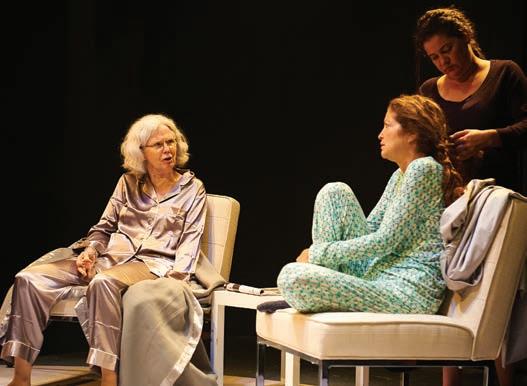 By KERRY REID
By KERRY REID
To view Nora Helmer’s girlish high spirits as proof of immaturity is as much a mistake as viewing Blanche DuBois’s flights of nostalgia as proof of weakness. Both of these indelible dramatic heroines reach their breaking point (or in Nora’s case, a breaking-away point) only after making huge—and unsung—sacrifices for their families. True, Nora’s forgery of her dying father’s signature in order to get the loan she needed to save her husband Torvald’s health is technically a crime, whereas Blanche drowned in legal debt shepherding sick relatives on their “long parade to the graveyard.” But neither are weak women: rather, they are women worn out by the pretenses of weakness piled on top of their overworked shoulders—pretenses the immature man children who surround them insist upon to assuage their own egos.
When things fall apart for both, it happens quickly. The speed of Nora’s transformation from seemingly naive and childlike wife and mother to a woman bent on seeking her own destiny is reflected in Writers Theatre’s current 90-minute adaptation of Henrik Ibsen’s A Doll’s House by Sandra Delgado and Michael Halberstam. In Lavina Jadhwani’s nimble, acerbic staging, Cher Álvarez’s vivacious Nora doesn’t get much time to breathe before the
enormity of what she’s facing as a result of that long-ago forgery crashes in on her. Meantime, Greg Matthew Anderson’s self-important Torvald can’t see beyond his own desires for a toy wife. As feminist writer-philosopher Lou Andreas-Salomé has noted, his “delight in simple gaiety and loveliness is . . . a conventional person’s reluctance to face any serious struggle which could disturb the aesthetic somnolence that allows him to enjoy life with self-satisfaction.”
Some of the subtlety is undeniably lost in speedy translation here, but what’s gained is a sense of urgency. Arnel Sancianco’s green birdcage walls suggest both the frailty of the Helmer home and the thinness of social barriers through which secrets will inevitably seep. The corollary characters—the anguished creditor Krogstad (Adam Poss) who tries to bring Nora down, Nora’s steadfast but lonely old school friend, Christine (Tiffany Renee Johnson), the dying Dr. Rank (Bradley Grant Smith), and the housemaid Anne Marie (Amy J. Carle), who sacrificed her own children to care for other people’s—get perhaps less stage time than in the original. But that only makes their observations on class and gender more pointed and timely.
Sometimes the show feels as if it’s straining for contemporary cred, as when Nora lets loose with profanity for its own sake. But the end (spoiler alert: that famous door doesn’t really slam) puts a rather more optimistic spin on the next chapter for Nora. As for Torvald? Well, maybe it’s time he hangs up his narcissism and learns to love other people, in all their fullness and their flaws. v
This line of thought leads to the kind of paradoxical conceit that underlies all theater worth its salt, namely that science is too important a factor in our lives to be left up to mere scientists.
There is more to know about the world than can be learned inside a large hadron collider, even if that knowledge is lost on high-powered physicist Alice (Cindy Marker) and her peers at CERN Labs in Geneva, where she’s been working for 11 years. Alice’s sister Jenny (Julia Siple) is in town and in crisis, having made tabloid and mumsnet.com headlines back in London after exposure to conspiracies made her an anti-vaxxer and led to the loss of her only daughter.
Whatever Jenny’s massive shortcomings, whatever idiotic mistakes she may have made—she’s “completely devoted to being stupid,” in Alice’s cold-blooded estima-
The action of the play is essentially these three individuals contending with their mutual inability to understand one another’s pain. Alice’s son Luke (Alexander Stuart) comes out as collateral damage. Everyone has their way with him until, finally, enough is enough. He scores a kind of victory by running away from home, throwing Alice’s life into an all-consuming “chaos” that her binary cause-and-e ect rationality is incapable of untangling.
At two hours and 45 minutes, this show, directed by Jaclynn Jutting, has a lot of arc to get through on its way to a brilliant second half and final anticlimax. A lot of it is chat, which isn’t a bad thing, but chat, especially British chat, can’t be delivered as though every sentence were the most important thing the character has ever said.
The wonderful Thalken seems to understand this the best out of the cast; her throwaway insults carry a sting the more harsh the less full-throatedly she speaks them. Julia Siple may simply be too much of a powerhouse for that kind of delicacy. Her performance contains some of the rawest intensity of any acting I’ve seen, either at this very special theater, now beginning its first season as an Equity company, or anywhere.
@mallerjour Mosquitoes LEE MILLERR Big Fish, big heart BoHo’s production of a Broadway flop breathes life into tall tales.
Based on Daniel Wallace’s 1998 novel and Tim Burton’s 2003 screen adaptation (screenplay by John August), Big Fish is a beguiling if paradoxical musical (book by August, songs by Andrew Lippa), at once larger than life and smaller, the kind of show that features a protagonist

life. The show feels tailor-made for an intimate space like the Greenhouse, where the production’s five-piece orchestra is right at the center of the stage and the actors are so close you could touch them.
Lippa and August, of course, meant the show to play in larger venues. It was first produced at the Oriental Theatre (now the James M. Nederlander Theatre) in Chicago in 2013, but the ultimate goal was always Broadway, where it moved later that year—and received decidedly mixed reviews. It closed a er only 98 performances and received no Tony nominations.
Broadway’s loss. As BoHo’s current revival proves, this can be a powerful, fascinating show. It helps that the production, under the direction of Stephen
Schellhardt and music direction of Michael McBride, is perfectly paced. And that Schellhardt’s cast is a true, tight ensemble; everyone has everyone else’s back, and as a result everyone shines—and the story unfolds with a grace that kees the audience riveted. Maybe Big Fish was always meant to flourish in a small pond. There is no shame in that. The Chicago theater movement was originally founded on the idea of many small (storefront) ponds, in which fish of many sizes thrive. —JACK HELBIG BIG FISH Through 11/17: Thu-Sat 8 PM, Sun 2 PM, Greenhouse Theater Center, 2257 N. Lincoln, 773404-7336, greenhousetheater.org, $35.
Cowardly Scarecrow’s barroom production of Cabaret is haunting and timely.

Cowardly Scarecrow Theatre Company turns Chief O’Neill’s Attic Bar into the Kit Kat Klub circa 1931 in its unrestrained musical adaptation of Christopher Isherwood’s stories of Nazi-era Berlin, first created by Fred Ebb and John Kander. Marc Lewallen’s and Brad Younts’s collaborative design and direction borrow freely from previous revivals (particularly Sam Mendes’s 1998 version), while reflecting our current cultural conversation on gender fluidity and sexual identity. Any historical piece set in a time of encroaching fascism can’t help but feel timely.
Performing along a diagonal runway that bisects a small barroom, with the audience seated at tables throughout, the cast pulls off the difficult trick of
constantly changing the direction and focus of action. Somehow, even when a singer was belting a number with her back to me, my disbelief remained suspended and I was not taken out of the story. It’s a testament to the scrappy ingenuity of the production that an ordinary flashlight pointed at a singer from behind the bar by a tech crew member reads convincingly as a theater spot. Kevin Webb hams it up as the leering, pansexual Emcee; Caitlin Jackson makes for a believably conflicted Sally Bowles; and Sydney Genco’s singing is a highlight in her portrayal of the shameless Fritzie Kost.
Occasional flat notes and overbroad gestures barely break the mood of the desperate debauchery this collection of misfits engages in as their world is about to crumble. The quiet procession being pinned with yellow Holocaust stars and multicolored triangles—representing other minorities that Nazis found subhuman—as the last strains of Cabaret fade to silence, stayed with me long a er I’d le the bar and won’t soon be forgotten.
—DMITRY SAMAROV CABARET Through 10/25: ThuFri and Sun 7:30 PM; also Mon and Wed 10/21 and 10/23, 7:30 PM, Chief O’Neill’s Attic Bar, 3471 N. Elston, cowardlyscarecrow.com, $28.50-$31.25.
Countess Dracula plays it too hasty and safe
I low-key love how Otherworld Theatre fully explores the concept of “theater nerd.” A recent Ninten-


do-covered update on Richard III was enjoyable and crunchy around the edges; it regularly offers Improvised Dungeons and Dragons. Otherworld is absolutely niche, but it’s absolutely itself.
This is why I went into Countess Dracula with a huge appetite for sweaty-palmed, glasses-on geekery. Conceptually, the show fits right in with the current zeitgeist of Black, southern gothics, a la Lemonade’s shadowy and foreboding moments and Angela Bassett in American Horror Story: Coven. Here, Countess Dracula is Black, loaded, and descended from African warrior women who licked the blood of men off their weapons when the wars were won. It’s the image we need in 2019.
The divine, the demonic, and the delectable all emerge in this Am’ber D. Montgomery and Nick Izzo adaptation (directed by Montgomery), but my biggest problem is with how tightly the playwrights cling to the source material, all at the cost of the show’s pacing and possibilities. A looser grip on Bram Stoker’s long (and sometimes meandering) bloodbath might’ve given the characters—played by a devoted and fiercely talented cast—more room for development and clearer desires. It would have allowed the writers to use more of the research they so obviously embarked upon. While I understand that fanfic requires a steady stream of familiar symbols, this is a plot worthy of some serious genre defiance. I’m thirsty for a little bit more. —KT HAWBAKER
COUNTESS DRACULA Through 11/2: Thu-Sat 7:30 PM, Sun 2:30 PM; no show Fri 10/11, Otherworld Theatre, 3914 N. Clark, 773-857-2116, otherworldtheatre. org, pay what you can (suggested donation $20).

As luck would have it, the most expedient way to describe vanguard camp comic and longtime Hell in a Handbag collaborator Ed Jones to the uninitiated might just be “imagine Mrs. Garrett from The Facts of Life, only
ten times Mrs. Garrett-ier.” So it’s an added bonus that this Halloween musical parody by David Cerda (score by Cerda and Andrew Milliken), which smuggles coke, ritualistic goat slaughter, and dry humping into the all-girls Eastland boarding school, gives Jones an opportunity to pay drag homage to his sister in spirit.
Suspecting that her younger sibling’s disappearance was the result of foul play, an amateur detective (Cerda) pulls a 21 Jump Street and infiltrates the prep school as a student. Alongside her hapless cohort disguised as a





janitor (Marissa Williams), she goes about uncovering an extracurricular sacrificial cult while navigating life as a teen for second time.

The colorful, neighborly, boozy upstairs stage at Mary’s Attic presents a tricky catch-22 here, where the atmosphere and vibe feel perfectly conducive for kitschy sketch fun, but the sound system is clearly more suited for MaryOke-Karaoke than an entire ensemble cast wearing face mikes. But once Jones and Cerda start pulling faces and chewing scenery in the grand and glamorous Charles Busch tradition, it’s hard to mind. Madison Smith’s witty and irreverent production also serves as an impressive showcase of young comedic talent, including Alexa Castelvecchi, Katy Campbell, and Graham Heacock in costumer Gregory Graham’s jaw-droppingly fishy drag. —DAN JAKES THE FACTS OF LIFE—SATAN’S SCHOOL FOR GIRLS Through 11/2: Wed-Sat 7:30 PM, Sun 5 PM; no performances Wed 10/9 and 10/16 or Sun 10/27, Mary’s Attic, 5400 N. Clark, 800-838-3006, handbagproductions.org, $28-$44 in advance, $30 at door.
R Hellhound on my trail City Lit’s adaptation of Arthur Conan Doyle’s The Hound of the Baskervilles is macabre and humorous.

Arthur Conan Doyle’s 1902 thriller is one of those classics most people are more familiar with from their o en tarted-up screen adaptations than the original. In this intimate City Lit Theater staging, director-adapter
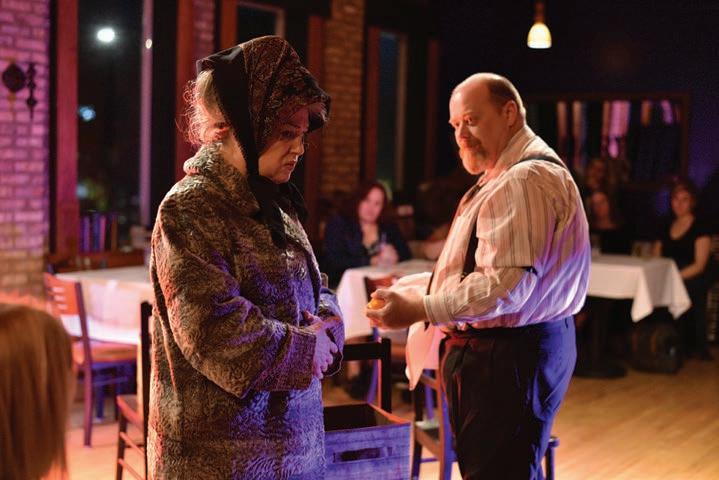




Terry McCabe returns to the source, following both the spirit and the letter of Doyle’s novel. McCabe employs the chamber theater format, in which a literary work is brought to the stage with minimal physical action and design and maximum fidelity to the text. The emphasis here is on words, mostly those spoken by the story’s narrator, Dr. John Watson, chronicler of the adventures he shared with his friend, Victorian “consulting detective” Sherlock Holmes. In Hound, Watson recounts how he and Holmes (principally Holmes) unraveled the mystery surrounding the death of a Devonshire aristocrat whose family was supposedly cursed by a demonic hound from hell—and prevented the murder of the aristocrat’s heir.

As in City Lit’s 2014 Holmes and Watson, Holmes and Watson are effectively embodied by James Sparling (whose aquiline profile helps make him a ringer for the famous Sidney Paget drawings of Holmes in the tale’s original magazine serialization) and Adam Bitterman, whose delivery is key to the production’s alternately macabre and wryly humorous tone. The supporting cast is solid and the design work is atmospheric. So is the incidental music—composed by Ben Chang and played live by violinist Eugene Kaler, who also provides the eerie howl of the hellhound. Good dog! —ALBERT WILLIAMS THE HOUND OF THE BASKERVILLES Through 11/10: Fri-Sat 7:30 PM, Sun 3 PM; also Mon 10/28 and 11/4, 7:30 PM, City Lit Theater, 1020 W. Bryn Mawr, 773-293-3682, citylit.org, $32, $27 seniors, $12 students and military.
Invisible pulls back the curtain on women in the Ku Klux Klan.


The world premiere of Her Story Theater producing artistic director Mary Bonnett’s drama, directed by Cecilie Keenan, explores the little-known role of women in stoking the Ku Klux Klan’s xenophobia and nativism in the 1920s. It’s a fascinating topic worthy of deep exploration given its germination on the heels of women’s suffrage and all-too-real ties to current events. But the production lacks the focus and critical eye necessary to understand how “everyday” people can coalesce around such dangerous movements.
Set in Mississippi in 1925, the story follows three members of the WKKK: Lucinda (Barbara Roeder Harris), a stern, high-ranking officer; Doris (Megan Kaminsky), her impressionable daughter-in-law; and Mabel (Morgan Laurel Cohen), a mother in mourning who’s been pulled along for the ride. The primary target of WKKK ire, an albino child called Ghost Girl (Maddy Flemming), brings an otherworldly, sometimes distracting, element to the story that serves as a vehicle for other characters to access their emotions by conversing with departed relatives.
Mabel’s inner torment over the WKKK’s treatment of minorities is the central tension of the story, played with grace and anguish by Cohen, but the creation of Lucinda and Doris’s belief systems could use more exploration. In one moment, Doris complains about the harsh judgment of women in a pie baking contest, saying “we are more than our pies and our crusts.” In the next, she’s excitedly sharing eugenics ideologies like forced sterilization of people that don’t look like her. That disconnect is the most chilling part of the story.
—MARISSA OBERLANDER INVISIBLE Through 11/3: Thu-Sat 7:30 PM, Sun 3 PM; also Sat 11/2, 3 PM, Stage 773, 1225 W. Belmont, 773-327-5252, herstorytheater.org, $35, $15 students.




Factory Theater combines Scooby-Do and pierogies in a seasonal haunted house comedy.
For the opening of its 27th season, Factory Theater presents Oh Sh#t! It’s Haunted!, a spooky Scooby-Doo-inspired, Polish-themed mystery written by Scott OKen and directed by Manny Tamayo. Henry Aldrichzewski (Jose Cervantes) and his cohort of idiot friends band together in order to assist Ma Aldrichzewski (Christy Arington) in finding somewhere to host the Polish American Festival, preferably somewhere with a staging area to cook pierogies and kołaczki. The old Lockwood place owned by creepy old geezer Peter Jasonczevik (Eric Frederickson) becomes the sought-a er venue— except for the fact that it’s haunted by a band of ghost musicians. Mrs. Ingersson (Stacie Barra), the hilariously corrupt money-grubbing landlord, has her eyes on acquiring the haunted old Lockwood place as well.
Fredrickson’s Peter and Barra’s Mrs. Ingersson kept the production rolling with their sinister over-the-top appearances, like true Scooby-Doo villains. The ghost band—complete with a Jimi Hendrix look-alike—didn’t really fit into the story. But the killer opening dance number and the homage to Scooby and the gang add up to a fun time. Oh sh#t! It wasn’t terrible! —TED PIEKARZ OH SH#T! IT’S HAUNTED! Through 11/9: Fri-Sat 8 PM, Sun 3 PM, Factory Theater, 1623 W. Howard, 866-811-4111, thefactorytheater.com, $25, $18 students and seniors.
Eclectic Full Contact’s Richard III turns the monstrous monarch into a garden-variety jerk.
Shakespeare’s Richard IIIis the embodiment of a man with a chip on his shoulder, a hunchbacked aristocrat who feels “cheated” of the joys of living by his “deformity.” Fancying himself denied the pleasurable pursuit of love, he declares that he is “therefore . . . determined to prove a villain.” But unlike the average “incel” cowering behind a sock puppet on Reddit, he is also a Plantagenet of the House of York, with more than the average number of weapons and warriors to hand. Ruthless Richard is unafraid of things that would make the Thane of Cawdor quake. Blood is nothing; power is all. Lock up your children.
In Eclectic Full Contact Theatre’s production, directed by Natividad Uehara, Richard (Andrew Pond) is just a garden-variety ass in a bar—a karaoke bar with rose-themed decor where satin-clad souses sidle up to a mike that seems to lay the curse of crooning flat.
One song that becomes a refrain in this production is literally about a “bowl of crap.” “I’m so full of crap,” belt an unlucky man and woman, one before and one a er intermission. What this has to do with Richard, it is difficult to know, and what motivates the man besides his arrogance is bludgeoned out of this rendition, where everyone emotes by shouting and no one seems to have read the words coming out of their mouths before.
Though Buckingham is Buckingham and Gloucester is Gloucester, toward the end, Richard is declared the “King of Chicago.” Why? —IRENE HSIAO RICHARD III Through 11/3: Thu-Sat 8 PM, Sun 2 PM; also Sat 10/26 and 11/2, 2 PM, Athenaeum Theatre, 2936 N. Southport, 773-935-6860, eclectic-theatre.com, $25 Thu and Sat and Sun matinees, $30 Fri and Sat nights.
In Sherlock’s Last Case, the insufferable sleuth meets unexpected foes.
The joke goes that someone could win the caption-a-cartoon contest in the New Yorker every week by going with “Christ, what an asshole.” That sentiment captures the Sherlock Holmes in Charles Marowitz’s 1984 play, Sherlock’s Last Case, now in a stylish and witty revival at suburban First Folio under Janice L. Blixt’s direction.
Kevin McKillip’s Holmes is an insufferable prat, prone to verbally abusing his Scottish housekeeper, Mrs. Hudson (Belinda Bremner), and casually putting down Dr. Watson (Joe Foust) when he’s not making the good doctor stir his stumps (war wound and all) down the stairs to pick up various missives.
A threatening letter arrives from a man purporting to be the son of the late Dr. Moriarty, Holmes’s archenemy (who “killed” the detective in 1893, until public outcry forced Arthur Conan Doyle to resurrect him). Holmes’s curiosity is piqued—even more so when Moriarty’s daughter, Liza (Lydia Hiller), arrives to warn him of her brother’s plans.
Various intriguing twists and turns emerge with enough Holmesian in-jokes to satisfy the faithful. But Marowitz’s real goal seems to be showing us Holmes as his creator grew to see him. Doyle once mournfully observed, “If I had never touched Holmes, who has tended to obscure my higher work, my position in literature would at the present moment be a more commanding one.” McKillip tears into the oblivious-jerk qualities of the detective with gusto, well matched by Foust as a long-suffering sidekick who is also beginning to question his friend’s high opinion of himself. —KERRY REID SHERLOCK’S LAST CASE Through 11/3: Wed 8 PM, Thu 3 PM, Fri 8 PM, Sat 4 and 8 PM, Sun 3 PM, First Folio Theatre, Mayslake Peabody Estate, 1717 31st St., Oak Brook, 630-986-8067, firstfolio. org, $34 Wed-Thu ($29 seniors and students), $44 Fri-Sun ($39 seniors and students), $10 children 14 and under.
Rough House Theater’s The Silence in Harrow House offers atmosphere but not much story.
It’s a toss-up for me between the floating torso with a desk lamp for a head and the disembodied hand holding, improbably, a whisk. These are a few of the evil, cunningly devised puppets ghouling it up at this Rough House Theater show, a hybrid haunted house and wordless play. Entering deranged architect Milton Harrow’s studio through the basement at the Chopin, we are greeted by his creations. Displays along the walls (no touching, please, except where you see a “touch me” sign) show his unfulfilled plans for an ideal society, from scale models of bleak fortresses to a cassette tape playing his spooky dicta on an endless loop. Harrow House’s lampshades strongly resemble Frank Lloyd Wright’s—and a very Prairie School Halloween to you too! Suddenly, from around the corner, or down at your
feet, comes a squawk, a scraping fingernail, a screaming face. These sad monstrosities, their amazing puppet features designed by Grace Needlman, are the failed results of Harrow’s human experiments. And here they are doomed to writhe for all eternity—or for 45 minutes, anyway.
I don’t think anyone goes to acting school expecting to one day be the black-clad operator of a severed hand puppet, but there you go. If you are able to look past the dude or pair of dudes piloting the appendage across the room, the atmosphere—labyrinthine partitions, Corey Smith’s vicious sound design—will momentarily take over. I only ever got the illusion to last that long, though. Mike Oleon directs. —MAX MALLER THE SILENCE IN HARROW HOUSE Through 11/10: Thu-Fri 7 and 8:45 PM, Sat 6, 7:45, and 9:30 PM, Sun 6 and 7:45 PM, Chopin Theatre, 1543 W. Division, roughhousetheater.com, $32, $20 industry and limited income.
There are tender lunar moments in Raven’s latest, but not enough spark.
Twin sisters—an academic with a Fulbright and a struggling songwriter—return from New York to their small Tennessee hometown a er their divorced father gets suspended from his teaching job. But it soon becomes clear that the women need their own reckoning with their personal problems. And what the family can’t say to each other clearly, they try to say in songs.
In Sundown, Yellow Moon, Rachel Bonds follows a familiar blueprint, but the play, now in a local premiere at Raven directed by Cody Estle, doesn’t coalesce. The songs, by husband-and-wife duo the Bengsons, have a lilting poignancy to them. There are several moments that edge into quiet but painful acknowledgment of familial conflicts that are mercifully devoid of histrionic revelations.

Yet the play feels overly determined and schematic to its detriment. Scholar Joey (Diana Coates) meets melancholic married poet Ted (Josh Odor) by the reservoir, and remembers him reading at her high school years ago. Similarly, sister Ray (Liz Chidester) recalls that Carver (Jordan Dell Harris) played with his band at her middle school. That band went on to great acclaim, leaving Carver in the dust, trying to put other people (like their father) back together as a counselor. Will these “outsiders” touch the women in ways their family cannot? Well, what do you think?

The actors, particularly Will Casey as Tom, the loving (though sometimes truculent) father, all find individual moments where we connect with them. But they remain frustratingly disconnected from each other. Their tendency to talk at each other feels like a playwright’s self-conscious interior monologue, particularly in the scenes with Ted and Josie. Still, we grow to like these people, even if we don’t feel as if we’ve really learned a lot about them by the end. —KERRY REID SUNDOWN, YELLOW MOON Through 11/17: Thu-Sat 7:30 PM, Sun 3 PM, Raven Theatre, 6157 N. Clark, 773-338-2177, $46 ($43 online), seniors and teachers $41 ($38 online), students, active military, and veter-
$15, Thu $15 for
under 30.
Sam Raimi directed this 1981 horror feature fresh out of film school, and his anything-for-an-effect enthusiasm pays off in lots of formally inventive bits. The film is ferociously kinetic and full of visual surprises, though its gut-churning reputation doesn’t seem fully deserved: if anything the gore is too picturesque and studied, an abstract decorator’s mix of oozing, slimy color, like some exotic species of new-wave interior design. There’s a weird comic energy in the frenetic physical playing—hysterical actors running in and out of rooms, zombies popping up from the floorboards and out of wall cabinets like jack-in-the-boxes—and the mad Punch-and-Judy orchestration takes on an almost choreographic quality at times (this may be the first commedia dell’arte horror film). There are lots of clever turns on standard horror movie formulas, and one image especially lingers in the mind: a woman splintering into an infinity of hairline cracks, like the suddenly shattered surface of a ceramic vase. With Bruce Campbell and Sara York. —PAT GRAHAM NC-17, 85 min. Fri 10/11-Sat 10/12, midnight. Music Box
This gritty, downbeat comic book movie imagines the life of Batman’s archnemesis before he realized his calling as a supervillain. Set sometime in the 1970s and clearly inspired by the look and feel of “Fun City” New York, it follows the exploits of Arthur Fleck (Joaquin Phoenix, in another outstanding performance), a troubled loner who earns his living as a clown for hire, dreams of making it as a stand-up comedian, and spends his nights caring for his homebound mother. Martin Scorsese’s Taxi Driver and The King of Comedy are the obvious points of reference here, though the depiction of Arthur’s mental illness—which walks a fine line between sympathy and clinical fascination—is clearly a product of the DSM-5 era. Christopher Nolan may have brought a sense of grim realism to comic book movies first with his Batman series, The Dark Knight trilogy, but I found this superior; the characterizations more interesting and genuine. Todd Phillips, in a far cry from The Hangover, directed; with Robert De Niro, Zazie Beetz, and Frances Conroy. —BEN SACHS R, 122 min. Showing in 70mm at
the Music Box Theatre. Digital presentations elsewhere. AMC Dine-in Block 37, Century 12 and CineArts 6, Music Box, Navy Pier IMAX, New 400, River East 21, 600 N. Michigan, Webster Place 11
Bong Joon-ho’s Palme d’Or-winning satire is easily the South Korean writer-director’s best film since Memories of Murder (2003), exhibiting the earlier film’s formal control and mounting suspense while incorporating the trenchant insights into class conflict he displayed in Snowpiercer (2013). The members of a poor family that manipulates the system in order to live by barely working scam their way, one by one, into servant jobs for a wealthy family that remains blind to the others’ machinations as long as they don’t disrupt their own lazy lifestyle. The film is unsubtle in its commentary on contemporary society’s concentration of wealth in the hands of a few; however, Bong complicates the satire with a dark second-act revelation that points to how our unjust economy forces the bottom portion of society to fight (in this case literally) over dwindling resources. Throughout, the director’s camerawork and mise en scene are impressively subtle, carefully parsing out information about characters and setting to force viewers to stay alert to the tiniest details. In Korean with subtitles. —BEN SACHS R, 132 min. Century 12 and CineArts 6

Yvonne Welbon (Living With Pride: Ruth C. Ellis @ 100) wrote and directed this warm and expertly craed video documentary (2003) about the history of black women in American cinema, from Zora Neale Hurston’s ethnographic projects in the 1920s to current indie directors like Kasi Lemmons (Eve’s Bayou) and Julie Dash (Daughters of the Dust). In the process she spotlights some forgotten pioneers—like Eloyce King Patrick Gist, a Texan who produced race films in the 30s—and elicits sharp observations from people like Neema Barnette and Jessie Maple, who broke into the business via TV in the 60s. Welbon ends on an upbeat note, predicting even more breakthroughs in the next decade. But when Chicago’s own Coquie Hughes appears near the end, her street dialect (“You know what I’m sayin’?”) contrasts dramatically with the “white” English of the more




Hosted by Reader’s Ben Joravsky and Maya Dukmasova

With special political guests from the LGBTQ community: Julio Rodriguez, Michael Ziri, Stephanie Skora and Ald. Maria Hadden
Doors open 5 p.m. Program 5:30-6:30 p.m.

Then join us to watch on CNN:
Sen. Cory Booker
Former Vice President Joe Biden
Mayor Pete Buttigieg
Sen. Elizabeth Warren
Sen. Kamala Harris
Former Rep. Beto O’Rourke
Sen. Amy Klobuchar
Former HUD Secretary Julián Castro
Businessman Tom Steyer
subject to change.
successful interviewees, suggesting that, for all the celebration of “new voices,” some accents aren’t yet welcome in the mainstream. —J.R. JONES 62 min. Welbon attends the screening. Wed 10/16, 7 PM. Northwestern University Block Museum of Art F
Fritz Lang’s penultimate work (1959)—a two-part adventure saga set and partly shot in India—marked a return, in more ways than one, to his masterpieces of the silent era. On a literal level, the project is a remake of another diptych from 1921 that Lang developed with his former wife, Thea von Harbou (who also wrote the novel on which the films are based); but more importantly, it’s driven by powerful, architectural mise en scene reminiscent of that of Metropolis and Spies. The films take place in the fictional Indian kingdom of Eschnapur and center on a German architect (Paul Haubschmid) who’s been hired by the Maharajah (Walther Reyer) to construct schools and hospitals. The architect falls in love with the Maharajah’s betrothed (Debra Paget), a naive but passionate temple dancer, and their affair so enrages the prince that he turns from benevolent to wrathful almost instantly. (His transformation occurs near the end of The Tiger of Eschnapur, setting the stage for his brutal revenge in The Indian Tomb.) As all this is going on, the ruler’s brother plots to usurp the throne, and there are provocative conversations about the will of the gods that reflect Lang’s career-long obsession with forces beyond human control. This is a work of Orientalism that borders on camp—all the principal Indian characters are
played by Western actors, and the depiction of India plays up the country’s exoticness—but as film historian Tom Gunning has noted, it’s an Orientalist vision as personal and visually inventive as Jack Smith’s Flaming Creatures, which was made only a few years later. Lang’s handling of color, blocking, and suspense is masterful throughout; if you’re at all interested in this major film artist, you can’t miss this. In German with subtitles. —BEN SACHS 203 min. The Tiger of Eschnapur: Fri 10/11, 2 PM; Sun 10/13, 3 PM; and Mon 10/14, 6 PM. The Indian Tomb: Fri 10/11, 4 PM; Sun 10/13, 5 PM; and Wed 10/16, 6 PM. Gene Siskel Film Center


One could say that Canadian biologist Anne Innis Dagg is the Jane Goodall of giraffes, except it’s worth noting
Get showtimes and see reviews of everything playing this week at chicagoreader.com/movies



that, at age 23, she traveled by herself to South Africa to study the long-necked creatures in the mid-50s—a few years before Goodall began her work with primates. Though Innis Dagg was certainly ahead of her time, she’s o en been overlooked in terms of public recognition. Now 86, Innis Dagg is the focus of filmmaker Alison Reid’s glowing documentary. Reid traces her subject’s life from age three, when she first encountered curious and majestic giraffes during a visit to the Brookfield Zoo. As an adult Innis Dagg went on to become not only the first woman but the first scientist of any gender to study animal behavior in the wild in Africa. With Reid, Innis Dagg returns to the site of her innovative research, and the accompaniment of vivid color photographs and 16-millimeter footage the scientist herself took in the late 50s render the duality of the experience all the more bewitching. Though the doc touches on the sexism Innis Dagg experienced in academia throughout the ensuing years, it’s most galvanizing in the scenes that show her out in the field doing the work for which she will now, I hope, be more widely remembered. —LEAH PICKETT 83 min. Reid and Dagg attend the Saturday and Sunday screenings; Amy Roberts, Senior Curator of Mammals, Chicago Zoological Society/Brookfield Zoo, attends the Saturday and Wednesday screenings. Fri 10/11, 2 and 8:15 PM; Sat 10/12, 5 PM; Sun 10/13, 2:30 PM; Mon 10/14, 6 PM; Tue 10/15, 8:15 PM; Wed 10/16, 6 PM; and Thu 10/17, 8:15 PM. Gene Siskel Film Center
A two-day festival of Bosnian-Herzegovinian shorts and features. For a full schedule, visit chicagobhfilm.org. Fri 10/11, 5:30-9:30 PM, and Sat 10/12, 3:30-9:30 PM. Ryan Auditorium, Technological Institute, Northwestern University F
Part of the touring Ism, Ism, Ism series of experimental films and video from Latin American, this program includes six films (1980-2016) from El Salvador, Paraguay, Mexico, Venezuela, Puerto Rico, and Columbia. 74 min. Co-curator Jesse Lerner attends the screening. Sat 10/12, 7 PM. Filmfront F
A “masterclass” discussion between filmmakers Gregory Nava (El Norte) and Barbara Martinez Jitner (American Family), moderated by Chicago Latino Film Festival founder and director Pepe Vargas, about the role of Latinx cinema in the present political climate. Mon 10/14, 7 PM. Facets Cinematheque

A two-day festival of films dealing with mental health issues. Sat 10/12, 4-10 PM, and Sun 10/13, 3-10 PM. Comfort Station F

Abbas Kiarostami directed this 2004 Iranian documentary, an extended first-person discussion of his filmmaking practice as he sits in a car, traveling through the countryside. Dubbed into English. 88 min. Sat 10/12, 5 PM. Gene Siskel Film Center v
 By F. AMANDA TUGADE
By F. AMANDA TUGADE
This past Easter Sunday, Lou Della Evans- Reid walked across the stage at First Church of Deliverance, where the 89-year-old serves as a music adviser. Though she’s not quite four foot 11, when she leads that choir she transforms into a monumental presence. Dressed in a white robe, she stood underneath an illuminated cross and opened her arms wide like Moses parting the Red Sea, summoning a hundred singers to follow her.
Evans-Reid is known for directing not just the choir but the congregation as well. As she yelled out the next line, she spun around to bring the audience in, then turned back to herd her vocalists, shepherding a call-and-response exchange. The choir and congregation met in unison at the chorus, with piano and drums marching behind, ready to deliver God’s message. The harmonies of the crowd and
Lou Della Evans-Reid takes the stage at First Church of Deliverance. When she directs a choir, she says, her chronic back pain falls away: “I feel like God is guiding my hands.” GEOFF STELLFOX FOR CHICAGO READERLou Della Evans-Reid spent nearly 40 years as minister of music for Fellowship Missionary Baptist Church, but even at age 89 this trailblazer isn’t done spreading the good news.
the choir’s four sections collided, swallowing Evans-Reid whole—until that moment, you might not have realized that the microphones onstage were live, but the PA speakers suddenly seemed to blare with overwhelming massed voices. Evans-Reid raised her right hand, tossed her head, and let out one last roar to close the song.
To watch Evans-Reid perform is to witness Black history. “I just ask the Lord to direct me,” she says. “You direct me, Lord, and I’ll direct the choir. Some days, I don’t know what I’m going to do until the spirit hits me.”
the civil rights movement in the 1960s. EvansReid served as its music director from 1963 till her retirement in 2000.

SEPTEMBER20.....
SEPTEMBER21.....WAGNER&MORSE


FEBRUARY24.....
SEPTEMBER22.....THE

SEPTEMBER23....WHOLESOMERADIODJNIGHT
MURPHYTHOMPSON9:30PM
THERONANDRACHELSHOW
FEBRUARY25.....WHOLESOMERADIODJNIGHT

SEPTEMBER24.....RCBIGBAND7PM
FEBRUARY26.....RCBIG BAND7PM

BIRDGANGS9:30PM
FEBRUARY28.....PETERCASANOVA
SEPTEMBER26.....PETERCASANOVAQUARTET
MARCH1............SMILIN’
SEPTEMBER27.....DORIAN
MARCH2............ICE BOXANDBIGHOUSE
MARCH3............CHIDITARODAND
MARCH7............
In Chicago’s gospel scene, she’s a living legend, responsible for inspiring a fleet of musicians, producers, and choir directors across the city, the state, the nation, and even the world. A flock of fans—most of them loyal churchgoers from multigenerational families—often crowds around Evans-Reid after a Sunday service.
In 1950 Evans-Reid was one of five charter members of Fellowship Missionary Baptist Church, led by her older brother, the Reverend Clay Evans. “The Ship,” as it’s often called, has become a beloved south-side institution and a powerhouse in the world of gospel music, and it’s well remembered for its support of
Retiring hasn’t taken Evans-Reid out of the church, though. She still works with three choirs: she’s a music adviser for the one at First Deliverance, of course; she’s an executive board member and music coordinator for the advocacy group Gospel Music According to Chicago (GMAC), for which she also directs a choir; and she leads a traditional community choir of her own, which rehearses at Fellowship.
“She’s gospel. She’s good news,” says Pam Morris-Walton, 69, formerly an event coordinator for the city of Chicago and lead producer for the Chicago Gospel Music Festival. Now host of a gospel radio program on iconic Black news and talk station WVON 1690 AM, MorrisWalton says Evans-Reid’s rendition of the hymn “A New Name in Glory” is still a favorite on her weekend broadcast.
In this community, Evans-Reid—in fact the whole Evans family—is a household name. Lou Della, her brother Clay, and Fellowship Missionary Baptist are usually mentioned in the same breath.

Chicago is the birthplace of gospel music, and in the 1950s Fellowship became the epicenter for traveling gospel singers, musicians, and preachers. Bishop Walter Hawkins, a 1981 Grammy winner from the Oakland-based Love Center Choir, passed through the church, and in the 1950s so did the Reverend C.L. Franklin and his young daughter Aretha, who later became the Queen of Soul. Frequent visitors from the city itself included Sam Cooke and James Cleveland.
In fact, before Evans heard his calling to the ministry, he was a bright-eyed young singer from Brownsville, Tennessee, who’d come to Chicago in search of a better life and landed a chance to perform alongside Cleveland in famed gospel group the Lux Singers.
The Reverend Jesse Jackson has been a member of Fellowship Missionary Baptist for more than five decades. Evans ordained him as an associate minister in the summer of 1965 and cofounded Jackson’s Operation PUSH in 1971. And last month Kanye West helped celebrate Fellowship’s 69th anniversary by performing at the church, following his morning gospel service on Northerly Island.
Like gospel music itself, the Evanses’ legacy is rooted in oral tradition. People love to tell stories about how Clay became a momentous figure during the civil rights movement, how Lou Della used to run up and down the church aisles, how a thousand people would gather for a live broadcast at Fellowship at 11 PM on a Sunday. This is history that’s not often spoken outside of the Black community, and it can easily be lost as soon as the song ends, the service comes to a close, and Evans-Reid picks up her purse and walks out the door.
Even the story of the construction of Fellowship’s current home (at 4543 S. Princeton) sounds like a parable from the Bible. In 1966 Evans defied Mayor Richard J. Daley to welcome Martin Luther King Jr. to the city. His decision to stand with Dr. King jeopardized his plans to give his church, then located in a converted garage on South State Street, a new building.
Jesse Jackson had cosigned the mortgage loan to finance the new church’s construction, but Evans-Reid says the city of Chicago put a stop to the project by interfering with building permits. For seven years—until it was finally completed in 1973—what’s now Fellowship was just a steel skeleton waiting for its body. While the city and the nation remained divided, Fellowship’s bare bones became a beacon of hope.
“Reverend wasn’t afraid,” Evans-Reid says. “He wasn’t afraid. He says, ‘You can’t! You have to be courageous! You can’t be afraid as a leader. I stand for my folks.’”
“I found myself praying so much for him,” she says. “I prayed for the Lord to keep him on a straight and narrow path, and that he would be able to go head-on and become the pastor
and the preacher, the man of God that God wanted him to be.”
Pastor DeAndre Patterson, 53, who serves at Destiny Worship Center on the west side and Miracle Revival Cathedral in Maywood, remembers those trials. “God be to glory that none of that steel rotted during that time, that the church is still standing here years later,” he says. He grew up in Christian Tabernacle Church at Prairie and 47th, a mile from Fellowship.
“I was a kid, but I do remember, because we had family on 53rd and Morgan, and we would drive past and I’d say, ‘Mom! Grandma! What is going on with the building?’” he says. “And they would tell us stories about the mayor,

A stylized painting of Mama Lou hangs above the fi replace in her living room. Her niece bought it at a garage sale while on vacation in New Orleans 25 years ago.
STELLFOX FOR CHICAGO READERbecause Reverend Evans stood with Reverend King.”
During that time, Evans advised his followers to fast and pray, just as Jesus, his apostles, and countless other biblical figures had done as a way to seek God’s comfort, guidance, and protection. “When we fast and pray, we fast and pray to God,” Evans-Reid says. “We asked him to answer our prayers, if it’s his will and his way.”
Hundreds of Black Chicagoans sought refuge at Fellowship in those years, swelling its congregation. With their freedom and future at stake, they turned to Clay and Lou Della for strength. She believed that singing together could bring salvation. Gospel music had descended from African African spirituals, grown from slavery and carved out of struggle. Backed by her traditional choir, Evans- Reid used the power of praise to uplift.

“Sometimes, it’s just the words of the song,” she says, and recites the first hymn that comes to her mind. “What a friend we have in Jesus / All our sins and our griefs to bear / What a privilege, a privilege it is to carry.’”
“It just gives them hope,” she says. “It’s hope for you. That’s it. The church is hope. The songs are hope for the people.”
JIn the family room of Evans-Reid’s home in southwest-side Wrightwood, a large portrait of her hangs above the fireplace. The gold frame forms a halo around her angelic

figure, and she appears to be singing in a long, white robe before a congregation. It’s like a scene from the transfiguration: she basks in the light of the Lord.
Evans-Reid has a story that goes along with that painting. She laughs as she explains that her niece found it at a garage sale in Louisiana. Her niece paid $40 for it—Evans-Reid kept the receipt as proof.
Dozens of awards honoring her work as Fellowship’s most beloved music director hang on the walls, cover the tables in the living room, and rest on the lid of her piano near the front door. In her dining room, she’s hung a letter from former Illinois governor George Ryan congratulating her upon her retirement from Fellowship almost 20 years ago. And though she’s never met Barack and Michelle Obama, she got a letter from them in 2010 wishing her a happy 80th birthday.
Evans-Reid loves to talk about her birthdays, because she believes that’s where her story starts. She was born on the seventh day of July, the seventh month, and she’s the seventh of ten children. In the Book of Genesis, God created the world in seven days. The number seven symbolizes completeness.
“This has been an enjoyable life,” she says. “I’m so glad that God decided—he decided this before I was born, that this is the way that he wanted me to go. I didn’t know about it, but I haven’t rebelled against it. Not at all.”
Although 14 years have passed since her 75th birthday, Evans-Reid likes to revisit it. She still has extra copies of the booklet and DVDs made for the party Fellowship threw for her in 2005. It’s not about bragging rights with Evans-Reid. It’s that she’s still overwhelmed by the hundreds of people who packed the church that night to be with “little old me.”
In the eyes of many of those people, EvansReid is a trailblazer: she’s a Black woman who’s held leadership roles in the church. Of the five charter members of Fellowship, two of whom were Evans-Reid’s brothers Pharis and Joseph, she was the only woman.
Evans-Reid served as the church’s first pianist, and when she became its minister of music in 1963 (a more formal way to say “music director”), she oversaw the senior, young adult, and youth choirs, which performed together on Sundays. By 1980, total membership in those groups had swelled to 200.
“A lot of people, especially the younger generation, don’t really know her,” says Fred Nelson III, 59, a family friend who’s musical director at New Faith Baptist Church Interna-
Mama Lou visits her 94-year-old brother, the Reverend Clay Evans, at his home in Roseland. “Half of him is me, and half of me is him,” she says. “I know we’re grown, but I still look up to him as my big brother. I can talk to him about my problems and ask for advice.” Behind Clay’s head is a photo of him with the Reverend Jesse Jackson and Muhammad Ali. GEOFF STELLFOX FOR CHICAGO READER
tional in Matteson. He’s also spent many years as a music executive, and served as conductor and musical director for Aretha Franklin from 2011 until her passing in 2018. “What’s more important probably at the end of the day is not Mama Lou, but what she brought to the platform, whether people ever know who she really was,” Nelson says. “What she brought to the movement is bigger than her little fourfoot self. I mean, really, it’s what she brought, and they may never know.”
Evans-Reid was 20 years old when she followed in Clay’s footsteps and moved to Chicago from Brownsville, a small town an hour away from Memphis. With Pharis by her side, she arrived here on Labor Day weekend in 1950. She was newly divorced with a baby and in search of a new beginning. Her mother had encouraged her to leave Brownsville and their cotton farm behind and to make something of herself. Evans-Reid even changed her name: born Ludella Evans, she chose to split her first name in two. “I changed it to a capital L-o-u,” she says, laughing. “That’s a man’s name, but I didn’t know no di erent.”
To this day, Evans-Reid looks up to her mother, who taught her strength and the value

of hard work. While her father managed the cotton farm, her mother grew an acre of vegetables to sell. Evans-Reid likes to tell a story that illustrates her mother’s independence: she traded in her horse and buggy for a car, so she could get to the city faster with those vegetables.
“I’m like my mom,” Evans-Reid says. They both had that “go-getter” attitude, she explains.
Between Lou Della and Clay, he was recognized as the great orator, towering over his podium, delivering sermons so powerful that Jesse Jackson still repeats the tale of the first time he heard Clay on the radio. It was July 5, 1965, and he was driving to church when he heard the reverend say “I must tell Jesus” in
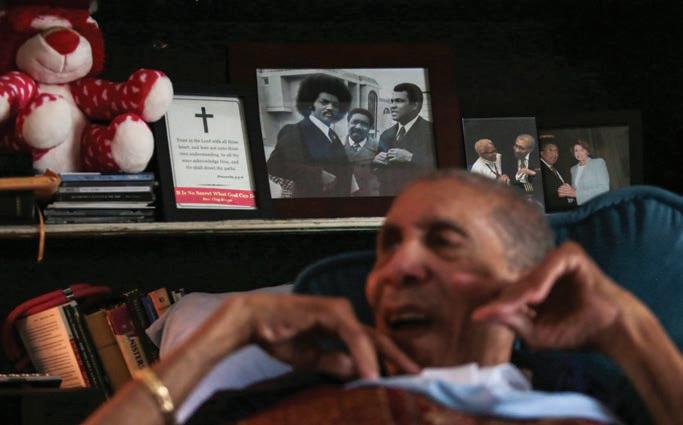
what he describes as the most “profound and spiritual way.” Jackson turned his car right around and headed for Fellowship. Lou Della, on the other hand, became known as an animated choir director with a knack for composing, handpicking talent, and putting on a show.
“Lou Della is an icon,” says Pastor DeAndre Patterson. “People went to see her. They didn’t only go to see her brother. They went to see her. They wanted to hear the music.”
Patterson, Nelson, and Malcolm Williams, a 12-year choir director for the Gospel Music According to Chicago, all remember a time when Fellowship’s weekly radio broadcast and one-hour TV special dominated gospel media. The church took to the radio in 1952 and stayed there for five decades; its first











TV series, What a Fellowship Hour, launched in 1977 and ran till 1991. Both programs laid important groundwork for how gospel music should sound, look, and feel.
“Every Saturday night, my grandparents would watch Fellowship,” says Williams, 49. “I used to watch her as a choir director on the church broadcast, and as she would direct at church, as she ran across the stage, I used to run across the living room trying to be her.”

Williams says Evans-Reid’s “natural spirit” caught his attention. “She had such a way of just commanding the choir, and at the time they had a humongous choir, probably the biggest choir I ain’t ever seen. To be able to lift your hands and you have 200 people who will do exactly what you want them to do at the same time, it was just amazing to me.”
There’s something else about Evans-Reid that Patterson, Williams, and many others have found endearing: She clearly cared about her choir. If she found out that one of her own was sick, she’d pray for them, call to check up on them, send cards with donations, and visit them in the hospital—and she encouraged other members of the choir to do the same.
Evans-Reid also has a silly side, which tends to show up during the quietest moments of a church service. “You could be sitting there, and she’ll lean over and say stuff that take you,” Williams says. “And it’s so bad! I’ll be laughing and tears are rolling down my face, and she’ll be sitting there with a straight face like she didn’t say anything.”
And it’d be an oversight not to mention her homemade sweet potato pie. The simple southern comfort dish is a coveted dessert at church gatherings.
“That’s why they call her ‘Mama Lou,’” Nelson says. “Everywhere she goes, she makes you feel like you in her family.”
That nickname, “Mama Lou,” didn’t come
from her choristers but instead from her coworkers outside the church. Evans-Reid was a surgical nurse for almost 50 years, securing her license in 1960 and retiring in 2007. Among the places she worked were Saint Anne’s Hospital on the west side and Saint Luke’s Hospital downtown, both now closed. She was used to being on call and on her feet for long shifts, and she loved taking care of people. She had a gift for healing.
“You live for other people,” Evans-Reid says. “That’s what our lives was about. What can I do to help somebody to get to where they’re trying to go? We got a song that we sing, ‘If I can help somebody, then my living shall not be in vain.’ And that’s true.”
On Wednesdays, Lou Della visits Clay at his home in Roseland. She’s usually heading to or coming from a noon prayer meeting at Fellowship when she stops by. These days Clay, 94, can often be found resting in his shaded bedroom, tucked under burgundy sheets with his companion dog, Angel, napping beside him.
During these visits, the two often talk about family, friends, or people from their past, some of whom might have celebrated new milestones or have moved on to the next life. Other times, they just talk about their days.
“How did you sleep last night?” Lou Della asks, reaching for his hand. “Pretty good,” says Clay. “I prayed. I said, ‘Lord! Let him sleep like a baby,’” she says.
For the most part, Lou Della says, she and Clay have been blessed with good health in their old age. Though they’ve both had serious scares since retirement (Clay in 2000 with pancreatic cancer, Lou Della in 2007 with thyroid cancer), they were both fortunate to catch the disease early. They had surgery and have been cancer free ever since.
But at their age, Lou Della says, they don’t
move or even speak the same way they used to. There’s a softness in Clay’s voice now; he follows every word he utters with a pause. His caregiver is on standby to o er help with everyday tasks. As for Lou Della, she relies on hearing aids and sometimes a walker.
For them, these weekly visits are sacred. “We are so close. We look alike,” Lou Della says. “Tell you the truth, he and I have been together longer than anybody in the world that’s living.”
“My brothers in between us and above me, they all gone,” she continues. “He and I are now closer to each other. We five years apart, but we’ve been together all these years.”
Even when Clay and Lou Della retired from Fellowship, they did it together. The running joke is that Lou Della did it reluctantly—or that she didn’t really retire at all. “Didn’t happen,” Patterson says bluntly. “He’s retired, living life. She’s still taking care of a choir.”
Nelson offers a story to illustrate what
separates Clay and Lou Della. A few years ago, he invited them to a gathering at his church in Matteson. “He sat up there,” Nelson says, pointing to the first pew at New Faith Baptist. “He didn’t even want to talk. He was just here in his white suit. They brought him in his Rolls
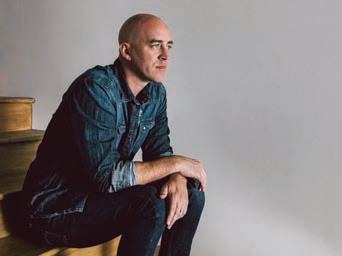
Royce, and he was this grandpapa. She directed a song with the choir, ‘It Is Well,’ and lit up the place. And they came here to do what they did, and they just left.”

“Keep-a-livin’” is Evans-Reid’s motto. Her mornings are split between walking on

the treadmill in her basement and reading devotional books. Some nights, she might be over at Greater Harvest Baptist Church, where her GMAC choir rehearses, or working with the choir at First Church of Deliverance. Other days are reserved for Bible class, faith workshops, Sunday school, or church hopping with close friends. Recently Evans-Reid spent a weekend at Greater Grace Church in Merrillville, Indiana, answering the call of a pastor who’d asked for her help. She worked with the church’s small choir and taught them a couple songs.
At choir practice or on Sundays, Evans-Reid still makes it a point to sit in the first seat in the front row. When a song starts, she tilts her head and lifts her right hand on cue, following the movement of the melody; she sings a verse or two before turning around to see if everyone else has joined in.

“Every night, it’s in my prayer,” she says. “I say, ‘Lord, I want to be pleasing and acceptable in your sight.’ That’s my prayer every night. . . . This has been a life. I’m always grateful to God and the people that helped me, that influenced me.”
For all her accomplishments, Evans-Reid hasn’t been canonized the way her most
famous brother has. Photographs on shelves behind Clay’s bed tell the story of his decades of service. A black-and-white print directly above him looks like a page ripped from a history book: he’s joined by a young Reverend Jesse Jackson and by Muhammad Ali, a poignant reminder of Fellowship’s influence and the roles all three men played as political leaders.

This iconic image is woven into Fellowship’s history, but Lou Della’s contributions are mentioned in marginal notes if at all. Her story remains alive through song and praise on any given Sunday.
Lou Della can always tell when her visits with Clay have come to an end. She can see it in the way he nestles his head against his pillow. Before she leaves, she asks him if there’s anything else she can do. With a nod and a simple gesture, he gives her leave to move around his room quietly. She adjusts his pillow once more and straightens out his blanket.
Drawing the curtain to close the day, Lou Della lets Clay sleep. She picks up her things and walks out the door, ready to tend to her work still left undone. v

ZAMROCK IS AN OLD STRAIN of African popular music that’s increasingly returning to the spotlight. The term references its country of origin, Zambia, as well as a particular funky brand of acid rock. Equally indebted to James Brown and Black Sabbath, the Zamrock sound was birthed in the 70s by the band Musi-OTunya, solidified by the fuzzy electric guitar of Paul Ngozi from the group Ngozi Family, and furthered in groups such as the Peace, Amanaz, and W.I.T.C.H., aka We Intend to Cause Havoc. Led by singer Emanyeo “Jagari” Chanda (who took his nickname from Mick Jagger) and originally called the Mighty Witch, W.I.T.C.H. became perhaps the most popular Zamrock band. They released now-classic albums such as 1972’s In the Past, 1974’s Introduction, and 1975’s oft-reissued Lazy Bones —widely acknowledged as a garage-psych masterpiece. Chanda quit in the late 70s, when an oppressive government regime forced the band to perform before a restrictive nightly curfew. Conflicting reports say he found God
or became a teacher or began working as a gemstone miner (and all might be true). But W.I.T.C.H. carried on into the mid-80s with new singers and a more disco-infused sound. Sadly, today Chanda is the only surviving member of the group—the AIDS epidemic took the lives of his former bandmates. After the Now Again label released a W.I.T.C.H. box set in 2012, new listeners got turned on to the group’s sounds, and Chanda was approached by Dutch psychpop sensation Jacco Gardner and his friend Nic Mauskovic to perform a set of W.I.T.C.H. songs with the two of them playing backup. This led to a European tour and a few west-coast appearances over the following year. In May 2019, the documentary W.I.T.C.H.—We Intend to Cause Havoc came out, and at last W.I.T.C.H. are making their first proper U.S. tour (with Canadian guitarist Michael Rault joining Gardner in the backing band). It’s only nine dates long, so don’t sleep on this very rare chance to shake your booty to live W.I.T.C.H. music. —STEVE KRAKOW
 b ALL AGES
b ALL AGES
Cave In War on Women, Sweet Cobra, and Lazer/Wulf open. 8 PM, Metro, 3730 N. Clark, $21. 18+
The winding story of Boston band Cave In is full of massive triumphs and heartbreaking pratfalls, and they’ve kept on trucking no matter what comes their way. Formed in 1995 as an extreme metalcore band, Cave In debuted in 1998 with Until Your Heart Stops , whose layers of corrosive vocals, dual guitar shredding, and unrelenting double kick drum essentially drew up a blueprint for generations of like-minded bands to follow. Cave In’s crowning achievement was their second LP, 2000’s Jupiter, on which they shed hardcore almost completely, opting instead for the shoegazy progressive space metal that became their signature sound, with front man Stephen Brodsky trading in his shrill growl for an operatic vibrato. The album is huge, weird, beautiful, and polarizing—you either loved it or you hated it, but even its biggest critics had to admit that nothing out there at the time sounded like it. Jupiter caught the attention of a lot of people, including major labels, and Cave In signed to RCA for their 2003 follow-up, Antenna , where they reined things in a bit while keeping the spacey vibes; a tour opening for the Foo Fighters followed. But Cave In proved too weird for the majors, and soon enough they were back to indie-heads-only territory. They broke up in 2006, reunited in 2009, and then released a full-length studio album, a live album, a rarities compilation, and two EPs. In early 2018 Cave In were demoing material for another new record when bassist Caleb Scofield was killed in a horrific car accident. Scofield was the band’s heart and soul; his thunderous low end provided the driving melodic foundation for a sound with its head in the stars, and when the band started experimenting with metalcore again a er their major-label stint, he covered the harsh vocals with his punishing growl. Cave In cleaned up those demos and in

PICK OF
After almost 50 years, Zamrock legends W.I.T.C.H. finally make their U.S. debut
June released them as Final Transmission (on Hydra Head, which is essentially in retirement but pops up occasionally for special projects), a beautiful record that sounds like classic Jupiter -era Cave In from front to back. The band have also played a handful of shows in Scofield’s memory with Nate Newton of Converge filling in on bass. This fall Cave In are on their first large-scale tour in years, which is also their first without Scofield. It’s not to be missed—I saw their first show with Newton on bass last summer in Boston, and it was as crushing as it was emotionally draining.
—LUCA CIMARUSTIVictor Internet Lowerlipdrip opens. 7 PM, Subterranean, 2011 W. North, $13. b.
For those who frequent the spaces where Chicago’s hip-hop, indie-pop, and dance scenes converge, the title of Victor Internet’s latest release, last month’s EP Victor’s Debut, will seem like a misnomer. Known to his family as Victor Cervantes, he launched his grassroots music career a little more than two years ago, uploading romantic bedroom-pop songs to Soundcloud. In early 2017, when he was just 17, he sold out of the first run of a self-released CD-only EP called Glitter98 . And this year has been even bigger for him: this summer, Cervantes landed a midtier slot at the fi h annual Ruido Fest, opened a few tour dates for young Latinx bedroom-pop maven Cuco, and started releasing music (including Victor’s Debut ) through Universal- distributed indie label Terrible, which has also worked with Miya Folick, Kirin J. Callinan, Solange, and Empress Of. The new EP makes a great calling card for Cervantes, showcasing his spellbinding ability to write songs that ooze with longing and seamlessly blend electronic pop, indie rock, and hip-hop—a fusion that feels like an extension of his musical interests, not a calculated attempt to maximize his audience. Cervantes could probably just reduce a couple of his songs to templates, repeat versions of them ad infinitum, and ride that out successfully, but fortunately he seems to earnestly want to find creative new ways to explore the nuances of heartache, romance, and societal anxiety. When he pitch-shi s his bittersweet vocals down on “Unfair,” combining them with a lonesome key melody and speedy breakbeat, he sticks the landing so well you’ll wonder how you ever made a playlist without him. —LEOR GALIL
In the context of black metal, the term “cosmic” has been diluted into worthlessness. When I applied it to Oranssi Pazuzu in 2013, I still thought it referred to an identifiable flavor of evil psychedelia, but now it just means “the guitarist has the correct effects pedals”—the same way “jazzy” means “a saxophone is involved” and “operatic” means “somebody took voice lessons.” So I propose calling the music of these Finnish xenonauts something more specific: wormhole black metal. Cofounded in 2007 by guitarist and vocalist Jun-His (aka Juho Vanhanen, former front man of surrealist rock band Kuolleet Intiaanit), Oranssi Pazuzu plunge you into a tunnel of fatally deformed spacetime, bathe you in a sizzling cocktail of exotic radiation, and spit you out somewhere cold, dark, alien, and very, very far away. Their hypnotizing riffs, eccentric cycles of accents, and bizarre harmonic tensions bear surface similarities to other avant-garde black metal, but Oranssi Pazuzu cover a vastly broader spectrum of frequencies and textures. Guitars and electronics grind, simmer, hum, sweep, pulse, twang, and twinkle, conjuring a universe of domed asteroidal colonies bristling with obelisks, of sentient plasma clouds that hollow out planets, of ancient and malevolent emperors who speak through wires drilled into their frozen brains. Too o en, the nihilism of black metal displays a poverty of imagination, leaning on wornout blasphemies against an equally boring divinity, but Oranssi Pazuzu juice up their interstellar incantations with the campy lunacy of gonzo science
 Oranssi Pazuzu RAINER PAANANEN
Oranssi Pazuzu RAINER PAANANEN

fiction—they invent apocalypses that nobody has a name for yet. Earlier this year, the band collaborated with Finnish drone-doom outfit Dark Buddha Rising on the album Syntheosis (Svart), billed to the Waste of Space Orchestra, but they haven’t released a full-length of their own since 2016’s Värähtelijä (20 Buck Spin). Oranssi Pazuzu started posting studio updates in August, though, so album number five should arrive soon—and their first U.S. tour, which kicks off with their Chicago debut, will definitely include new material. Let’s leave “cosmic” to bowling alleys—I know some tentacled space vampires you need to meet.
—PHILIP MONTORO J




continued from 41

Charli XCX Allie X opens. 8 PM, House of Blues, 329 N. Dearborn, $89. b


When Charli XCX dropped the single “Blame It on Your Love” on May 15, she posted an Instagram story of herself posing with guest vocalist Lizzo and a sign reading “Bout 2 Save Pop Music.” The British singer’s new full-length, Charli (released last month), suggests that she’s not just trying to save pop—she’s trying to shift the pop paradigm. She hasn’t succeeded yet, but the complicated and occasionally chaotic Charli feels like a stepping stone in that direction—its songs don’t immediately feel ready for the Top 40, but they further her distinctive sound. The album builds on the distorted electro-pop Charli has explored since 2017, when she made a sharp departure from a radio-friendly rock-influenced sound. With its layered synths and screeches, Charli posits itself as the future of pop music, but rather than being decades ahead of its time, it’s just a few years down the road. (“I’m so 2021,” she boasts on the dense hyperpop track “Click.”) As she did on the guest-crammed 2017 mixtape Pop 2, Charli once again serves as pop music’s resident BFF: the 15 tracks, almost all produced or coproduced by A.G. Cook of the PC Music collective, include 12 featured artists, among them Troye Sivan, Sky Ferreira, and Big Freedia. But Charli shines brightest on her solo songs, such as the lovelorn “Thoughts” and the masterfully stripped-down ballad “Official.” In interviews and on social media, Charli has struggled with her lack of chart success, and she recently announced that she won’t perform any songs from her first two albums on this tour—a choice that reflects where she’s at in her career. Suspended in a strange ether between Top 40 and experimental pop, she’s working hard to define her particular sound and waiting to see if the world catches up. —MEGAN KIRBY
Rezn & Lume Not for You and Borer open. 8:30 PM, Empty Bottle, 1035 N. Western, $12. 21+






It would be worth an outing to the Empty Bottle just to see two of the most compelling bands Chicago has produced in recent years on one bill. Dark postrock trio Lume entered the fray last year with their full-length debut, Wrung Out (Equal Vision), a raw, emotional, and cinematically dreary work that examines loss from every angle with its combination of fuzzed-out guitars and beguiling vocals. Also last year, four-piece Rezn released their second full-length, Calm Black Water , a beautiful heavy monster that adventurously and seamlessly weaves together psychedelia, doom, and electronics. But this show offers more than just a stacked bill: what makes it really special is that Lume and Rezn have recorded a collaborative 12-inch, Live at Electrical Audio , that features two long, rippling, building tracks, “Hi” and “Lo.” The EP, which was indeed recorded live at Electrical Audio, is available in digital and vinyl versions, and the mix has been adjusted to account for each format’s weaknesses and strengths. At the Bottle each band will play their own short set, and then they’ll come together to re-create and build on the energy of the EP. —MONICA KENDRICK
Pharmakon Bloodyminded and Itsï open. 8 PM, Co-Prosperity Sphere, 3219 S. Morgan, $10. b



For New York noise artist Margaret Chardiet, aka Pharmakon, the body is a wet, alien thing that hangs on the self like meat on a butcher’s hook. Her defining album, 2014’s Bestial Burden (Sacred Bones), chronicles a serious illness and hospitalization. It opens with the multitracked sound of her desperate breathing, in a claustrophobic symphony that makes



you feel like you’re being asphyxiated. Throughout the album she screams and coughs and vomits searing electronic barrages in a terrifying evocation of her own disintegrating shell. And on her recent fourth full-length, Devour (Sacred Bones), Chardiet pants and spews as she circles around related themes. The title refers to self-cannibalism, which Chardiet sees as a metaphor for fascist violence and for our species-wide effort to drown the planet in our own waste products. “Self-Regulating System” layers on factory clatter and throb, a machine
invented to pound listeners to a paste. “There is an all-devouring hunger / Which distends deprivation,” she rasps on “Deprivation” as power electronics chew away at her voice, swallowing identity and meaning alike. Chardiet’s live shows are famously intense; she sometimes writhes on the ground, as if trying to escape her skeleton and organs or give birth to them. Some noise artists confine their palettes of whines and roars to abstract realms, but Chardiet mercilessly embodies the rawest of emotions. —NOAH BERLATSKY


from
Aiming for Enrike Ands and Imelda Marcos open. 9 PM, the Owl, 2521 N. Milwaukee. 21+ F
Oslo’s Aiming for Enrike accomplish a lot with a little: though they’re just a duo, armed with guitar, drums, and a small infantry of effects and loop pedals, they craft detailed, propulsive, dancy mathrock instrumentals. Their sound owes as much to dance punk as to prog rock, calling to mind complex, groove-based bands such as Battles, Trans Am, and Adebisi Shank. The two-piece are releasing their fourth LP, Music for Working Out, in January, and now they’re bringing their blistering dose of booty-moving beats to the U.S. for the first time. In advance of that upcoming material, guitarist Simon Følstad Nilsen and drummer Tobias Ørnes (who also drums for Norway’s Shining and for Ihsahn of Emperor) have delivered six new singles— their danciest, grooviest tunes to date. The first of them, “Hard Dance Brainia,” is a certified stomper, with Nilsen layering infectious grooves and melodic scales over Ørnes’s in-the-pocket rhythms. Likewise, “Don’t Hassle the Hoff,” “Spice Girls,” and “Infinity Rider” are toe-tapping, head-nodding marvels of melody that render vocal accompaniment unnecessary. Set in the intimate confines of latenight Logan Square bar the Owl, this is a can’tmiss show for the instrumentally inclined. —SCOTT MORROW
Vic Spencer Ankhlejohn headlines; Vic Spencer, D. Brash, Thelonious Martin, and Nasim Williams open. Hosted by Money Mall. 8 PM, Emporium Wicker Park, 1366 N. Milwaukee, $10. 21+
It can be daunting to try to keep up with prolific Chicago rapper Vic Spencer, who chews urgently through his lines like his head is so overstuffed with ideas it could burst open. Spencer drops three or four albums every year, but he doesn’t just grind them out mechanically—he sets the highest standards for himself, and each new release is required listening for any savvy Chicago hip-hop head. In August, he released his third—but likely not his last— album of the year, Bah Wounds (Old Fart Luggage), which is packed with the kind of no-prisoners takedowns, self-deprecating jokes, and uber-earnest mash notes to hip-hop that fuel his best material. On “Dr. Sebi,” atop an unstable cluster of samples, he compares his rapping to a fixed-gear bicycle—a sly boast that suggests only the most serious listeners can handle him. But while Spencer cheekily refers to himself as a villain, he’s generous in his work—his songs are so jammed with great lines that anyone can easily find a favorite. —LEOR GALIL
Tegan and Sara 8 PM, Cahn Auditorium, Northwestern University, 600 Emerson, Evanston, $79.50. b

The last time Canadian twin-sister duo Tegan and Sara came through Chicago, they were on the road celebrating the tenth anniversary of 2007’s The Con . At the time, it seemed like a fairly standard move—lately it seems like practically every longrunning band has dusted off a fan-favorite album for a special show or tour. But what could’ve been just a victory lap became the catalyst for a revitalization. According to an interview the duo did with Apple Music, revisiting The Con inspired a burst of introspection that led to two major projects, the first of which is their recent memoir, High School , which looks back on the sisters’ adolescence. While working on the book, they came across demo recordings and lyrics they’d created as teenagers, and they turned that long-discarded material into the base of their brand-new record, Hey, I’m Just Like You. The twins rewrote and rearranged those fragments into songs that connect the ragged alternative rock they made early in their career with the joyful synth-pop that they currently specialize in. That delicate balance between new and old shines on the title track, an excited ode to outcasts finding each other that’s anchored by stark guitar and shimmering synths.
Slow burner “Don’t Believe the Things They Tell You (They Lie)” starts with short guitar strums and ominous, warbly synth and builds to a surprising, explosive spaghetti-western style guitar solo as Tegan and Sara aim their ire alternately at themselves and at a nebulous group of liars. On Hey, I’m Just Like You , the messiness and isolation of growing up queer, the fierceness necessary to establish a life on your own terms, and the pain and joy of that journey are all on display. Tegan and Sara have captured the urgency of their 1996 selves while cra ing an album that still feels like a step forward. While they are in town, Tegan and Sara will also make two appearances to promote their book: on Monday, October 14, they’ll be at Volumes Bookcafe at 7 PM, and on Tuesday, October 15, at noon they’ll be interviewed by Jessica Hopper at the Museum of Contemporary Art. —ED BLAIR
Bossa Iv King Tuts Tomb and Kid Hawk open. 8 PM, Subterranean, 2011 W. North, $10. 17+
Singer-songwriter Matthew McGarry caught my ear in 2012 with the charming, unruffled indie-rock tunes he released as Upholstery & Carpet Cleaning. By 2015 he’d dropped that name in favor of Bossa IV, and it’s been a pleasure to hear him refine his laidback style of rock. But the whole project could’ve come to an end in April 2017, when McGarry went deaf in his le ear. As he wrote in a detailed blog post, an urgent-care doctor diagnosed him with sudden sensorineural hearing loss (SSNHL), and the ENT he saw next said he had only a 50 percent chance of recovering some of his hearing. Fortunately, a er taking prescribed doses of prednisone, making two trips to an acupuncturist, and getting lots of rest, he was back to normal in roughly ten days. McGarry addresses his unexpected illness directly on the limber “Sudden Deafness,” on Bossa IV’s brand-new fourth album, Forget Your Name (Old Lane Sign), and the renewed sense of joy he gets from playing music energizes the entire album. When the dramatic, slow-boiling “Total Chaos” reaches its radiant apex, I imagine him levitating. —LEOR GALIL

Frank Waln Part of Indigenous Peoples Day Concert Chicago. NuFolk Rebel Alliance and Opliam open. 8:30 PM, Old Town School of Folk Music, Maurer Concert Hall, 4544 N. Lincoln. b F
Sicangu Lakota rapper, producer, and engineer Frank Waln celebrates and bears witness to the survival of Indigenous peoples in his compositions.

Born and raised on the Rosebud Reservation in South Dakota, Waln received his bachelor’s of arts in audio arts and acoustics from Columbia College Chicago and currently lives in Washington Park. He views his music as a vehicle to express his truth and encourage other people to see crucial issues through a lens not their own. In his raps he pushes back hard against the historical erasure that Indigenous peoples have suffered for centuries. He tells stories onstage to bridge his songs, and both his stories and his songs deliver impassioned, precise calls to honor those who lived in the Americas prior to colonization and to respect the worldview of their descendants. He o en explains a prophecy of the Plains people that predicts that a er seven generations of hardship following the group’s first contact with Europeans, Indigenous youth will bring about a time of great healing and recover the languages and cultures lost to centuries of cruelty and genocide. As Waln explains in an interview with Vocalo, the time of this seventh generation is now. He chronicles its rise and vision for the future in songs that highlight Indigenous empowerment and pride, in part by sampling Indigenous poets and elders in prayer. This concert promotes the celebration of Indigenous People’s Day, which takes place the second Monday of October (Chicago still officially recognizes it as Columbus Day, though at least six states and 130 cities, including Oak Park, have adopted Indigenous People’s Day instead). The evening will also feature NuFolk Rebel Alliance, who combine folk music from North and South America with punk, as well as Opliam, the rootsy hip-hop fusion project of concert coproducer Liam McDonald. —CATALINA MARIA JOHNSON
w.I.t.C.H. See Pick of the Week, page 40. Opener to be announced. 8 PM, Lincoln Hall, 2424 N. Lincoln, $25. 18+ v




7:30 PM, Riviera Theatre b Party Favor 11/30, 9 PM, Concord Music Hall, 18+ Willy Porter 2/13/20, 8 PM, SPACE, Evanston b Chad Price, Sammy Kay, Chuck Coles 11/21, 8 PM, GMan Tavern
Questlove (all-Prince DJ set), Shazam Bangles 11/1, 10 PM, Smart Bar
Raw Chicago Stellar showcase 11/20, 7 PM, Metro
Real Pretenders, Little Queens 10/24, 8:30 PM, FitzGerald’s, Berwyn Rodriguez 12/13, 8 PM, City Winery, on sale Fri 10/11, noon b
tickets for 10/15 show will be honored at the 10/28 show, refunds will be available if required b
Richard Thompson (solo) 12/28-12/31, 8 PM, SPACE, Evanston, 12/28 added; 12/2912/30 sold out b
AC Slater 2/28/20, 8:30 PM, Park West, 18+
A er Funk, Groovy Louie & the Time Capsules 11/29, 11 PM, Schubas
Badi & Clarice Assad 11/3, 7:30 PM, Szold Hall, Old Town School of Folk Music b
Assuming We Survive, We Were Sharks, Never Loved, Action/Adventure, High Wire 10/24, 8 PM, Beat Kitchen, 17+ Automatic 11/26, 9:30 PM, Hideout
Brendan Bayliss & Jake Cinninger 17th Annual Holiday Show 12/7, 8 PM, Park West, on sale Fri 10/11, 10 AM, 18+
Eric Bellinger, Ye Ali, Sy Ari Da Kid, Garren 12/11, 8 PM, Subterranean, 17+
Big K.R.I.T. 10/25, 7:30 PM, House of Blues b
Blacker Face, Why? Footclan, Augustine Esterhammer-Fic 10/18, 9:30 PM, Hideout
David Bromberg 5/2/20, 8 PM, Maurer Hall, Old Town School of Folk Music b
Bailey Bryan 11/12, 7:30 PM, Schubas, on sale Fri 10/11, 10 AM b
Burial Hex, Nika, Bloodyminded 11/23, 7:30 PM, International Museum of Surgical Science, on sale Fri 10/11, 10 AM, 17+
Canyon Sounds, Jason Duarte 11/1, 8 PM, GMan Tavern
Caribou 3/20/20, 7:30 PM, Riviera Theatre, 18+
Chadwick Stokes & the Pintos, Mihali 12/13, 8 PM, Lincoln Hall, 18+
Cowboy Junkies 3/5-3/6/20, 8 PM, City Winery, on sale Fri 10/11, noon b
Day of the Dowd 2 featuring Gerald Dowd with 45, Sons of the Never Wrong, Jonas
Friddle, and more 11/9, noon, FitzGerald’s, Berwyn b
Dead Can Dance, Agnes Obel 4/29/20, 7:30 PM, Chicago Theatre, on sale Fri 10/11, 10 AM b

Doctor P, Cookie Monsta 11/7, 8 PM, Mansion Nightclub, Stone Park, 18+
Duke Dumont 12/5, 10 PM, Sound-Bar
May Erlewine & the Woody Goss Band 4/16/20, 8 PM, SPACE, Evanston, on sale Fri 10/11, 10 AM b
Evil Eye: Halloween Chicago featuring DJ Dan, Keith Mackenzie, Dan Bain & Jaos, and more 10/26, 9 PM, Metro Fletcher Rockwell 11/22, 8:30 PM, FitzGerald’s, Berwyn Fly or Die with Jaimie Branch, Ben LaMar Gay 12/20, 8:30 PM, Empty Bottle, on sale Fri 10/11, 10 AM
Steve Forbert 1/10/20, 7 PM, SPACE, Evanston, on sale Fri 10/11, 10 AM b
Fabio Frizzi 11/18, 8:30 PM, Thalia Hall, 17+
Funkadesi 1/17/20, 8 PM, SPACE, Evanston b Helen Gillet 12/17, 7:30 PM, SPACE, Evanston, on sale Fri 10/11, 10 AM b
Ginuwine 11/22, 8 PM, Patio Theater b
Govinda, Ancient Mermaids, Alex Kislov 11/2, 10:30 PM, Chop Shop, 18+ Heilung 1/20/20, 7:30 PM, the Vic, on sale Fri 10/11, 10 AM b Hyborian, Migrator, Wardehns, Scumlord 11/21, 7 PM, Reggies’ Music Joint
Icon For Hire, Veridia 11/7, 7:30 PM, Subterranean b
Flaco Jiménez with Los Texmaniacs, Dwayne Verheyden 11/8, 8 PM, Maurer Hall, Old Town School of Folk Music b
Jon B. 1/5/20, 5 and 8 PM,
City Winery, on sale Fri 10/11, noon b
Theo Katzman, Rett Madison 3/6/20, 8:30 PM, Thalia Hall, 17+
Bruce Lamont/Che Arthur/ Skyler Rowe, Helen Money, Underhand 10/23, 8:30 PM, Empty Bottle
Dylan LeBlanc 12/4, 8 PM, SPACE, Evanston b
Ian Leith, Chris Neville, John Carpender 10/18, 8 PM, FitzGerald’s, Berwyn Luthi 11/4, 8 PM, Beat Kitchen Machine Head 2/15/20, 7 PM, Metro, on sale Fri 10/11, 10 AM b
Ian Maksin 11/23, 8 PM, Maurer Hall, Old Town School of Folk Music, on sale Fri 10/11, 9 AM b Maps & Atlases 11/23, 9 PM, Sleeping Village, on sale Fri 10/11, 10 AM
Lee McKinney, Felix Martin 11/24, 7:30 PM, Subterranean, 17+
Model Stranger, Blood Red Boots, Ballroom Boxer 12/7, 8 PM, GMan Tavern
Molly Drag, Past Life, Fay Ray 10/27, 7:30 PM, Subterranean, 17+
Morgan Wallen, Jon Langston, Ashland Cra 1/4/20, 8 PM, Rosemont Theatre, Rosemont, on sale Tue 10/15, 10 AM b
Murder by Death 3/14/20, 8 PM, Thalia Hall, 17+ Bob Nanna, Burst & Bloom, D.H. Currier 10/18, 8:30 PM, Beat Kitchen, 17+ Nghtmre, Zomboy, Whipped Cream, Wavedash 12/31, 9 PM, Aragon Ballroom, 18+ North Mississippi Allstars 1/16/20, 9 PM, Thalia Hall, 17+
Sinead O’Connor 3/14-3/16/20, 8 PM, City Winery, on sale Fri 10/11, noon b
Opeth, Graveyard 2/14/20,
Sean Rowe, Shane Leonard 11/20, 8:30 PM, Hideout Sadar Bahar, Mark Grusane, Darryn Jones, Marc Davis, Tone B. Nimble (DJ sets) 10/20, Conservatory Vintage & Vinyl, Flossmoor b Show Me the Body, Urochromes, Buggin Out 11/21, 7:30 PM, Subterranean, 17+ Silverstein, Four Year Strong, I the Mighty 4/7/20, 6 PM, Concord Music Hall, on sale Fri 10/11, 10 AM, 17+ Souther, Daymaker, Just Luckies 10/18, 8 PM, GMan Tavern Sub Urban 11/23, 8 PM, Schubas b
SuperM 11/13, 7 PM, United Center b Tautologic, Sleepersound 10/27, 7:30 PM, Reggies’ Music Joint
They Might Be Giants 3/6/20, 8 PM, the Vic, on sale Fri 10/11, 10 AM, 17+ Rob Warmowski Memorial Celebration with Defoliants, Pegboy, Cheer-Accident, Ono, San Andreas Fault, Buzzmuscle, Sirs, Silver Abuse, Watchmen, Dummy, 007, Mather High School Jazz Band, Martin Atkins, Eric Spicer, Scott Lucas and more 10/21, 6 PM, Metro, a tribute to Rob Warmowski and a benefit for the Chicago Coalition for the Homeless; hosted by Steve Albini b Keller Williams 1/24/20, 9 PM, Park West, on sale Fri 10/11, 10 AM, 18+ Wume, Bitchin Bajas, Watery Follies 11/25, 8:30 PM, Empty Bottle F
Yola 1/14/20, 8 PM, Thalia Hall b
Mike Zito’s Big Band Chuck Berry Tribute 2/9/20, 8 PM, SPACE, Evanston, on sale Fri 10/11, 10 AM b
Madonna 10/16-10/17, 8:30 PM; 10/21, 8:30 PM; 10/2310/24, 8:30 PM; 10/27-10/28, 8:30 PM, Chicago Theatre, 10/15 concert rescheduled;
Audien 11/15, 8 PM, Concord Music Hall, 18+
Aweful, Blood People, Dorian Taj 11/30, 9:30 PM, Hideout Geowulf 11/7, 9 PM, Schubas, 18+
Ghost of Paul Revere, Animal Years 11/23, 9 PM, Lincoln Hall, 18+
Maître Gims 11/3, 6 PM, Concord Music Hall b Giolì & Assia 11/15, 9 PM, Sleeping Village Goblin, Gigan, Lion's Daughter 11/7, 8 PM, Reggies’ Rock Club, 18+
Good Morning 10/19, 8:30 PM, Empty Bottle
Harvey Fox, Daydream Review, Space Gators 10/20, 9 PM, Sleeping Village Immortal Technique, Chino XL, Poison Pen 10/25, 9 PM, Metro, 18+
In Flames, Red, Arrival of Autumn 11/24, 7 PM, Concord Music Hall, 17+
John 5 & the Creatures, Jared James Nichols, Reverend Jack 11/2, 7 PM, Reggies’ Rock Club, 17+
Johnny Utah 11/11, 8 PM, Schubas, 18+
Rickie Lee Jones 10/20, 7 PM, Maurer Hall, Old Town School of Folk Music b
Booker T. Jones 11/14, 8 PM, City Winery b K. Michelle 11/13, 8 PM, House of Blues, 17+
Noah Kahan, JP Saxe 10/19, 8 PM, House of Blues b
Lucy Kaplansky 11/15, 7 PM, SPACE, Evanston b
Katastro, Bikini Trill, Dylan Reese 11/19, 8 PM, Beat Kitchen, 17+
Kayden 11/6, 7 PM, Schubas b Plain White T’s, Mowgli’s, New Politics 11/12, 7:30 PM, Metro, 18+
Trashcan Sinatras 10/22, 8 PM, SPACE, Evanston b
Frank Turner & the Sleeping Souls 10/17, 7 PM, Athenaeum Theatre b
Jaymes Young, Phil Good 11/16, 8 PM, Bottom Lounge b v
MANY BANDS associated with famous DIY punk label SST Records have been enshrined for posterity, but SoCal rippers Saccharine Trust, who combined gloomy punk, wiggly free jazz, and other weirdness during SST’s 80s heyday, haven’t gotten their due. In 2000, local filmmaker Jim Sikora released My Char-Broiled Burger With Brewer, which he describes as a “portrait of an old and enduring friendship between two musicians—one who is very successful (Mike Watt of the Minutemen and the Stooges) and the other (Jack Brewer of Saccharine Trust) who is sliding into obscurity.” On Sunday, October 20, at 5:30 PM, the Siskel Film Center will screen the 40-minute documentary as well as music videos Sikora has shot for the likes of Tar and Urge Overkill, followed by a discussion between Sikora and former Reader critic Jonathan Rosenbaum. Sikora is working on the rock-centric Michael Shannon vehicle I’ll Die Tomorrow and a “smaller picture titled Things I’ve Done , starring David Yow and Brian Dennehy.”
It’s been a few years since singer Sacha Mullin (known for work with Dead Rider, Cheer-Accident , and Lovely Little Girls) dropped the solo album Duplex, but the song “Crow” is still ringing in Gossip Wolf’s ears! Mullin is working on a new album with Dead Rider’s Todd Rittmann, and he just dropped an earnest, hilarious video for “Crow,” whose Pop-Up Video-style factoids about crows, reality TV, and Pokémon are only sometimes actual facts—last time this wolf checked, Renée Zellweger was still alive! On Saturday, October 12, Mullin celebrates with a show at Cafe Mustache
Last week, Chicago mashup masters the Hood Internet dropped “The Hood Internet Presents 1979,” a video that squeezes 50 hits from ’79 into three blissful minutes of cheeky pop. They’ll release another year’s video mashup each Thursday in October, concluding with “The Hood Internet Presents 1983” on Halloween—and that night they headline Schubas! —J.R. NELSON AND LEOR GALIL

Speaker of the House Nancy Pelosi has begun an impeachment inquiry into President Trump for asking Ukraine president Volodymyr Zelensky to investigate former vice president Joe Biden and his son Hunter. I get that there is a strong desire for many Americans to be rid of what they see as the national nightmare of Trump’s presidency. But I urge caution for several reasons.
First, this impeachment inquiry will not succeed in getting rid of Trump. To win, a supermajority of the Senate must vote for impeachment. This will not happen. Even if the inquiry clearly shows that Trump withheld military aid to pressure President Zelensky to give him dirt on Joe and Hunter,
the inquiry will also expose the sleaziness of the Bidens.

After the successful overthrow of the elected Ukrainian government in 2014, Hunter Biden was paid $50,000 a month to sit on the board of Ukraine’s biggest gas producer, Burisma Holdings. While this shady deal might not provide a legal defense to Trump, an impeachment inquiry is political, not criminal, and the behavior of the Bidens will at least muddy the waters enough to assure that Trump will survive impeachment.
Second, the mere fact that our corporate-controlled Congress is willing to take up the impeachment inquiry guarantees that it will produce no major reforms to better the lives of most Americans. Keep in mind

that our national politics is dominated by two political parties that are beholden to the interests of big-money donors. Sure, there are a few members of Congress who don’t rely on big donors, but they are the exception, and they do not control the agenda of their parties. Thus, rest assured that the big donors to Congress—big pharma, fossil fuel extractors, Wall Street, weapons manufacturers, agribusiness, big insurance, and for-profit health care—approve of its spending six months debating impeachment. Big business believes this impeachment inquiry will not threaten corporate profits or its ability to continue exerting control over government policy.
A dozen years ago, Speaker Pelosi rejected calls to begin an impeachment inquiry against President George W. Bush and Vice President Dick Cheney for lying us into the war in Iraq. The evidence there was clear and unambiguous. Bush and Cheney told the American people that there was “no doubt” that Iraqi president Saddam Hussein had weapons of mass destruction. In fact, as the Bush team knew, the evidence of Saddam’s WMDs was highly dubious. It was based on the word of a paid informant named Curveball, and on a crudely forged invoice purporting to show Saddam buying uranium from Africa. Both Curveball and the invoice were exposed as frauds, but Bush and Cheney continued lying to sell the war.
Bush’s lies resulted in the deaths of at least a million innocent people, the destruction of a country, and the creation of ISIS. He and Cheney committed monstrous crimes, similar to crimes resulting in the execution of German generals at Nuremberg after World War II. Why then did Speaker Pelosi announce in 2006 that impeachment was “off the table” for Bush? Because the big corporate donors didn’t want impeachment hearings over the Iraq war. Rather, the arms manufacturers, fossil fuel extractors, and other war profiteers want our presidents to be free to lie us into wars without any nega-
tive repercussions for the president, such as criminal penalties or impeachment.
The third reason I can’t get excited about impeachment hearings is that they won’t even be good entertainment. Back in October 1998, when Congress launched impeachment hearings against Bill Clinton relating to sex with an intern—another issue that was not in any way threatening to corporate profits—there were at least sordid details about a cigar and a stained dress that made it worthwhile turning on the TV.
To be sure, there are sordid details to the Ukraine story that could be exposed. After the U.S.-backed coup that overthrew the sovereign government, not only did Hunter Biden get a seat on the gas company board, but agricultural giant Monsanto got a big contract in Ukraine. Just last month, Trump’s special envoy for Ukraine negotiations, Kurt Volker, was forced to resign after it came out that he was advocating sending lethal tank-busting Javelin missiles, manufactured by Raytheon Co., to Ukraine, while Volker also worked for a lobbying fi rm and a think tank with fi nancial ties to Raytheon.
These revelations about Ukraine could help expose the deep-seated and longstanding corruption of U.S. foreign policy, which includes overthrowing elected governments to serve the interests of corporations that then support the campaigns of lawmakers and presidents, producing the endless cycle of wars that are bankrupting our nation and accelerating the destruction of the planet. But this part of the Ukraine story would be very threatening to corporate profits. So don’t expect to hear much about it during the coming months of impeachment inquiries. v
@GoodmanLenUnanswered questions from live shows in Chicago, Madison, and Minneapolis
 By DAN SAVAGE
By DAN SAVAGE
Q : If you use food for vaginal play, is there any type you should definitely avoid?
A : Lasagna makes for a lousy insertion toy. (Food doesn’t belong in vaginas; there could be bacteria on the food, even a er washing, that results in a nasty infection. #FuckFirst #EatA er)
Q : How do you feel about relationships that have a time frame or defined end point? For example, one person is going away for school or a new job?
A : I’m fine about relationships with seemingly set end points, as relationships don’t have to be open to or become long-term in order to be a success. (Did you meet a nice person? Did you have some good sex? Did you part on good terms? Success!) And the world is filled with couples that met at a time in their lives when school or work commitments meant they couldn’t be together—and yet, years or even decades later, they’re still together. You never know.
Q : Is it OK that I always seem to hate my partners’ mothers? Is this normal?

A : It isn’t and it’s not. When you’re the common denominator in a lot of high-stress, high-conflict relationships, you’re most likely the problem.
Q : Why do straight guys like anal so much?
A : Superhero movies, bottled beer, watching sports—there are lots of things straight guys like that I just don’t get. But I get why they like anal: Done right, anal feels amazing. And not just for the person doing the penetrating. When it’s done right, it is also great for the person being penetrated. And sometimes the person being penetrated is a straight guy.
Q : A er a year of dating, my boyfriend told me he is polyamorous. I don’t know how to proceed. Any tips?
A : If he meant, “Polyamory is my sexual orientation, and you have to allow me to date other people, and you can’t break up with me over this because that would amount to discrimination on the basis of sexual orientation,” that’s bullshit and this relationship is over. But if he meant, “Polyamory is a better relationship model for me than monogamy,” that’s not bullshit and the conversation is just getting started. If you prefer monogamy but you’re willing to consider polyamory to be with him, i.e., if that’s a price of admission you’re willing to pay, it could work out. But if you aren’t open to polyamory, and monogamy isn’t a price he’s willing to pay to be with you, it won’t work out.
Q : I work in secondary education and I’m in an open marriage. My job is awesome, but I’m so afraid of a student or a parent seeing me when I’m out with a different partner. What should I do?
A : You could hope people would mind their own business and continue to make out in public with your other partners—or whatever it is you’re doing in public that makes it clear you’re fucking/dating someone who isn’t your spouse— or you could be discreet. Since antidiscrimination statutes don’t offer protections to people in open relationships, and since people regularly freak out about teachers having sex at all, you really have no other choices besides discretion (when out with others) or shouldering the risk (of losing your job).
Q : My poly friend has started bringing her flavorof-the-week partners to social events instead of her awesome wife. How do I tell her I’d rather hang out with her and her wife than her and her (usually boring, always temporary) new fling?
A : Maybe your poly friend’s wife doesn’t want to hang out with you. Wait, I can say that in a nicer way: Maybe your poly friend’s wife is an introvert who would rather stay home and she’s only too delighted that the flavor-ofthe-week is willing to escort her wife to the box social. But if you miss your friend’s wife, maybe give her a call and invite her to lunch?
Q : My former lover cheated on his current livein girlfriend with me. She has no idea. Should I tell her what a narcissistic cheater her boyfriend is?
A : Vengeful former affair partners don’t have much more credibility than narcissistic cheaters—indeed, people view both with similar contempt. But you do you.
Q : My husband and I are swingers. For him, it’s who he is. For me, it’s something I do (and like!). We argue over how o en we go out or have sex with other couples. Any suggestions for finding a happy medium?

A : More o en than you’d like, and less o en than he’d like— call it the bittersweet spot.
Q : What tips do you have for lesbians in longterm relationships who want to keep sex fun and interesting?
A : My advice for lesbians who want to keep their LTRs hot is the same as my advice for gays, straights, bis, etc. who want to keep theirs hot. At the start of the relationship, you were the adventure they were on, and they were the adventure you were on. That’s why it was so effortlessly hot at the start. But once you’re not each other’s sexy new adventure anymore—once you’re an established couple—you have to go find sexy adventures together to keep it hot. And that requires making
a conscious effort. Explore your kinks, buy some sex toys, have sex someplace other than your bedroom, invite very special guest stars, etc.


Q : How do I create a sexier bedroom for even better sex?

A : Bedrooms are overrated, if you ask me (which you did), whereas basements, office stairwells, clean singleseat restrooms in upscale restaurants, dark corners of public parks, the space underneath banquet tables in hotel ballrooms, etc, are all underutilized.

Q : Can you explain why male chastity is such a popular kink? I’m not offended by it, just curious about its sudden widespread popularity.
A : “I think a big factor is that people are enjoying the heightened mental connections that tend to develop with chastity play,” said Christopher of Steelwerks Extreme, makers of the Rolls-Royce of male chastity devices. “Frequent business travel and longdistance relationships also make chastity an increasingly popular kink as the cage wearer and key holder can maintain a playful dynamic
without needing to be in the same room.”
Q : I’m 99.975 percent sure I don’t want kids. My boyfriend of almost four years has a vasectomy scheduled for the end of the year. Should we go through with it? My boyfriend is really fucking sexy, hence the .025 percent doubt.

A : Vasectomies, like pregnancies, are reversible. Your boyfriend could also go to a sperm bank and put a load or three on ice.


Q : Female, 32, straight, and very pregnant. I’m about to pop! Do you have any postpartum sex advice?

A : Explore outercourse for a while and try to have (or try to fake) a positive attitude about it.
Q : Your thoughts on transmasculine folks who don’t necessarily identify as men using the word “faggot”?


A : Fine, so long as they put the emphasis on the second syllable. v
Send letters to mail@ savagelove.net. Download the Savage Lovecast every Tuesday at savagelovecast. com. @fakedansavage

Wholesale Florist In-House Support Wholesale florist looking for a positive, energetic individual to provide in-house support. Duties could include processing fresh flowers, packing orders, loading and unloading trucks and cooler/ in-store cleaning. Please email your resume to chicago@ billdoran.com or come in and fill out an application at Bill Doran Company 222 N Fairfield Chicago IL 60612. (10/10)
CAREGIVER/HOUSEKEEPER URGENTLY NEEDEDIt is a part time job, liveout position from Tuesday to Friday. The position includes childcare and little housekeeping Must be able to interact with children Speak English, and non smoker MUST HAVE REFERENCES You an reach Mrs Claudia at Claudiapredacoop1960@ gmail.com
Delivery Driver - Business to Business We are looking for a positive individual with a clean driving record to deliver flowers/supplies to local retail florists. Approx. 30 hours per week. Must be able to lift up to 40 lbs. You must have a valid driver’s license, minimal activity in the past 5 years and no DUI in the past 7. Email your resume to Chicago@billdoran. com or fill out an application at Bill Doran Company, 222 N Fairfield, Chicago IL 60612. (10/10)
machine learning & a.i. needs. Req’s Mstr in Stats, Predictive Anlytics, Biz Anlytics, Data Sci, or rltd quantitative field & 3 mnths exp. For all reqs see: http://bit.ly/sdsCskky Mail Resumes: Crowe, LLP Attn: Mimi Bilbrey, 330 E. Jefferson Blvd, South Bend, IN 46601(10/10)
SSI (U.S.) Inc. d/b/a Spencer Stuart seeks Sr Associate and Associate Practice Leader, LAS N.A. in Chicago, IL. Req. Bachelor’s in HR or rltd + 5 yrs exp. in job offered or in rltd consulting or executive search occupation. Duties: serve in an internal leadership role overseeing and directing associate and analyst recruitments, onboarding, development and project deployment for LAS practice in N.A. Must have exp: (1) recruiting, managing, developing and deploying professional staffs in a consulting firm related industries; (2) performing executive searches and leadership advisory service practices; (3) managing client engagement lifecycle for developing and leveraging plans and productivity timeline; (4) utilizing assessment methodologies and tools such as ExI for organizational effectiveness; and (5) building talent development and business strategies that are aligned with appropriate cultures and values. Will have 25% travel requirement. Send resume to lreuther@ spencerstuart.com w/Job ID KL-SrAssPL0919.
This letter is to notify that on October 25, 2019 at 9:00 a.m. an auction will be held at 83rd & Halsted Self Storage, Inc., located at 8316 S. Birkhoff Ave, Chicago, IL 60620, to sell the following articles held within said storage units to enforce a lien existing under the laws of the state of Illinois.

1. 227 Robert Hill 2. 247 Cedric Sanders
3. 246 Oprah Lindsey 4. 202 Elmo Roberts 5. 128 Maggie Moore
This letter is to notify that on October 25, 2019 at 9:00 a.m. an auction will be held at Hyde Park Self Storage, Inc., located at 5155 S. Cottage Grove Ave, Chicago, IL 60615, to sell the following articles held within said storage units to enforce a lien existing under the laws of the state of Illinois.
1. 10183 Michael E. Ricketts

2. 566 Daniel Goldman
3. 504 Sylvia Prayer 4. 41 Joan C. Parker 5. 469 Phyliss Robinson 6. V333 Darryl Simmons 7. 10112 Marcellus Moore
JOBS ADMINISTRATIVE SALES & MARKETING FOOD & DRINK SPAS & SALONS BIKE JOBS GENERAL REAL ESTATE RENTALS FOR SALE NON-RESIDENTIAL ROOMATES MARKETPLACE GOODS SERVICES HEALTH & WELLNESS INSTRUCTION MUSIC & ARTS NOTICES MESSAGES LEGAL NOTICES ADULT SERVICES
Groupon, Inc. is seeking a Data Analyst in Chicago, IL w/ the following responsibilities: design customized data solutions, as a foundation of a global platform which horizontally provides multiple lines of business at Groupon, such as Local, Goods, Travel, & Getaway services. Apply at www.grouponcareers.com by searching keyword R22182 (10/10)
Groupon, Inc. is seeking a Salesforce Engineer in Chicago, IL w/ the following responsibilities: Develop, construct & implement the next generation of company products & features for Groupon’s web & mobile apps. Apply at www.grouponcareers. com by searching keyword R22172 (10/10)
Vertex Consulting Services, Inc. in Schaumburg, IL is seek’g A) IT Business Project Managers to serve as a liaison between bus & tech aspects of projs; B) Junior Network Administrators to instl, config., maintain & supp. IP ntwrk infra’s. No trvl; no telecomm. Job duties are proj-based & performed @ unanticipated sites w/in U.S. Relo may be req’d @ proj. end. Mail resumes to: Vertex Consulting Services, Inc., Attn: HR, 935 N. Plum Grove Rd., Ste D., Schaumburg, IL 60173. (10/10)
Full time floor sander and installer needed. Hard wood floor installation and refinishing company. Experience necessary. Visit https://www. plushardwoodflooring.com to learn more. (10/10)
Crowe, LLP seeks Senior Data Scientists in (Chicago, IL) Respnsble for wkng as part of a team to support all
INTL FCStone Inc. seeks a Global Head of Data (Job Code 541180) in Chicago, IL to design and implement a global unified data policy across business units and to establish/deliver the IT data strategy and manage data integration architecture. Up to 15% domestic travel required.
Mail resume referencing Job Code 541180 to Rosemary Carlson, INTL FCStone Inc., 1251 NW Briarcliff Parkway, Suite 800, Kansas City, MO 64116. EOE. (10/10)
This letter is to notify that on October 25, 2019 at 9:00 a.m. an auction will be held at South Shore Self Storage, Inc., located at 7843 S. Exchange Ave, Chicago, IL 60649, to sell the following articles held within said storage units to enforce a lien existing under the laws of the state of Illinois.
1. 477 Andrew Mason
2. 511 Angela Baskerville
3. 237 Da Great Yekuti Azor El 4. 602 Gregory Thomas 5. 464 Destiny Williams
6. 231 Rashaunda Sanders
7. 425 Darryl Hammons 8. 449 Ola Jackson
9. 314 Donald Haughton 10. 434 Candice McGhee 11. 479 Ola Jackson 12. 268 Cordell Hill
This letter is to notify that on October 25, 2019 at 9:00 a.m. an auction will be held at Aaron Bros. Self-Storage, Inc., located at 4034 S. Michigan Ave, Chicago, IL 60653, to sell the following articles held within said storage units to enforce a lien existing under the laws of the state of Illinois.
1. 436 Charisma Ward 2. 240 Malinda Forest 3. 552 Michael Weston 4. 556 Ronnie Holman 5. 442 Doretha Larkin 6. 245 Sabrina McEwen
Notice is hereby given, pursuant to “An Act in relation to the use of an Assumed Business Name in the conduct or transaction of Business in the State,” as amended, that a certification was registered by the undersigned with the County Clerk of Cook County. Registration Number: Y19002152 on September 13, 2019. Under the Assumed Business Name of SCP NEWSPAPER SALES. with the business located at: 2622 E 83RD STREET, CHICAGO, IL 60617. The true and real full name(s) and residence address of the owner(s)/ partner(s) is: Owner/Partner Full Name Complete Address SCOTT PARKER 2622 E. 83RD STREET, CHICAGO, IL 60617 (10/10)
STATE OF ILLINOIS, PUBLICATION NOTICE OF COURT DATE FOR REQUEST FOR NAME CHANGE. Location Cook CountyCounty Division - Case Type: Name Change from Anas Elshafei to Adam Anas Elshafei Court Date 12/16/2019, 1:30 PM in Courtroom #1202 Case # 2019CONC001197 (10/24)
STATE OF ILLINOIS, PUBLICATION NOTICE OF COURT DATE FOR REQUEST FOR NAME CHANGE. Location Cook CountyCounty Division - Case Type: Name Change from Juan Jesus Velazquez Jacobo to Nathan Velazquez Filed 09/18/2019
Court
STATE OF INDIANA ) IN THE LAKE SUPERIOR COURT JUVENILE DIVISION, CROWN POINT. INDIANA.
) SS: COUNTY OF LAKE ) Cause Number: 45D061902AD000028.
Lake County (Quest). Filed: 2/12/2019 3:43 PM. Clerk Lake County, Indiana.
IN RE THE ADOPTION OF: TRENT MOLINA, a minor child. MARY JANE STRAUBEL, Petitioner. And THOMAS E. STRAUBEL, Petitioner.


To the Biological Father, JUAN MOLINA, upon and against all persons claiming from, through or under them, and any other person who may be concerned: You are hereby notified that a petition for adoption of TRENT MOLINA has been filed in the office of the clerk of the Lake County Superior Court, Juvenile Division, located at 3000 W. 93rd Avenue, Crown Point. Indiana 46307.
If you seek to contest the adoption of the child, you must file a motion to contest the adoption in accordance with I.C. 31-19-10-1 in the above named court not later than thirty (30) days after the last date of publication of this notice.
If you do not file a motion to contest the adoption within thirty (30) days after the last date of publication of this notice the above named court will hear and determine the petition for adoption. Your consent to the adoption will be irrevocably implied and you will lose the right to contest either the adoption or the validity of your implied consent to the adoption.
No oral statements made to you relieve you of your obligations under this notice. This notice complies with 1.C. 31-19-4.5-3 but does not exhaustively set forth a person’s legal obligations under the Indiana adoption statutes.
A person being served with this notice should consult the Indiana adoption statutes.



Robert A. Plantz
Ind. Atty. No.: 22104-64 8105 Georgia Street Merrillville, Indiana 46410


Telephone: (219) 942-3710 (10/10)





Notice is hereby given, pursuant to “An Act in relation to the use of an Assumed Business Name in the conduct or transaction of Business in the State, “as amended, that a certification was registered by the undersigned with the County Clerk of Cook County, Registration Number: Y19002080 on August 30, 2019. Under the Assumed Name of Mo’Hawk The Mixher Mobile Bartending Services with the business located at 3145 W Flournoy, Chicago, IL 60612. The true and real full name(s) and residence address of the owners(s)/partner(s) is: Owner/Partner Full Name: Monique Rolling Complete Address: 3145 W Flournoy, Chicago, IL 60612 (10/10)

Miracle Message. Obtain health, energy and joy. Prolong your youth and life. Decrease illness with the possibility of healing. Call Jolanta: (847)6508989. 5237 W. Addison St.

Chicago, IL 60641 (11/07)
Danielle’s Lip Service, Erotic Phone Chat. 24/7. Must be 21+. Credit/ Debit Cards Accepted. All Fetishes and Fantasies Are Welcomed. Personal, Private and Discrete. 773-935-4995 (10/10)
52 year old incarcerated Black/Italian male seeks sincere, down to earth and genuinely openminded people (like myself) to correspond with. All welcome, I can’t wait to share my story and learn about yours.

Peter Saunders #B–00118 2600 N. Brinton Avenue Dixon, Illinois 61021

Large studio apartment near Loyola Park. 1337 W. Estes. Hardwood floors. Cats OK. Heat included. Laundry in building. Available 9/1. $850-880/ month. Sublease from 10/1/19 through 3/31/20 available for $765/month. (773)761-4318. www. lakefrontmgt.com (10/10)
Large studio apartment near Morse red line. 6826 N. Wayne. Hardwood floors. Pets OK. Heat included. Laundry in building. Available 11/1. $850/month. (773)761-4318. www. lakefrontmgt.com. (10/10)
Large one bedroom apartment near Morse red line 6824 N. Wayne. Hardwood floors. Pets OK. Heat included, Laundry in building. Available 11/1. $1025/month. (773)7614318. www.lakefrontmgt. com (10/10)
Large one bedroom
apartment near Loyola Park. 1335 W. Estes. Hardwood floors. Cats OK, Laundry in building. $995/month. Heat included. Available 11/1. (773)761-4318. www. lakefrontinet.com (10/10)


One bedroom apartment near Warren Park and Metra. 6802 N. Wolcott. Hardwood floors, Laundry in building. $995-1050/month, Heat included. Cats OK. Available 11/1. (773)761-4318. www. lakefrontmgt.com (10/10)
Spacious 2 BR/2 BA condo across from Millennium Park. Remodeled, parking, pool, and balcony with lake views. Available immediately. Option for furnished or unfurnished. $3200/m NGBL (312)852-1150 (10/10)

















